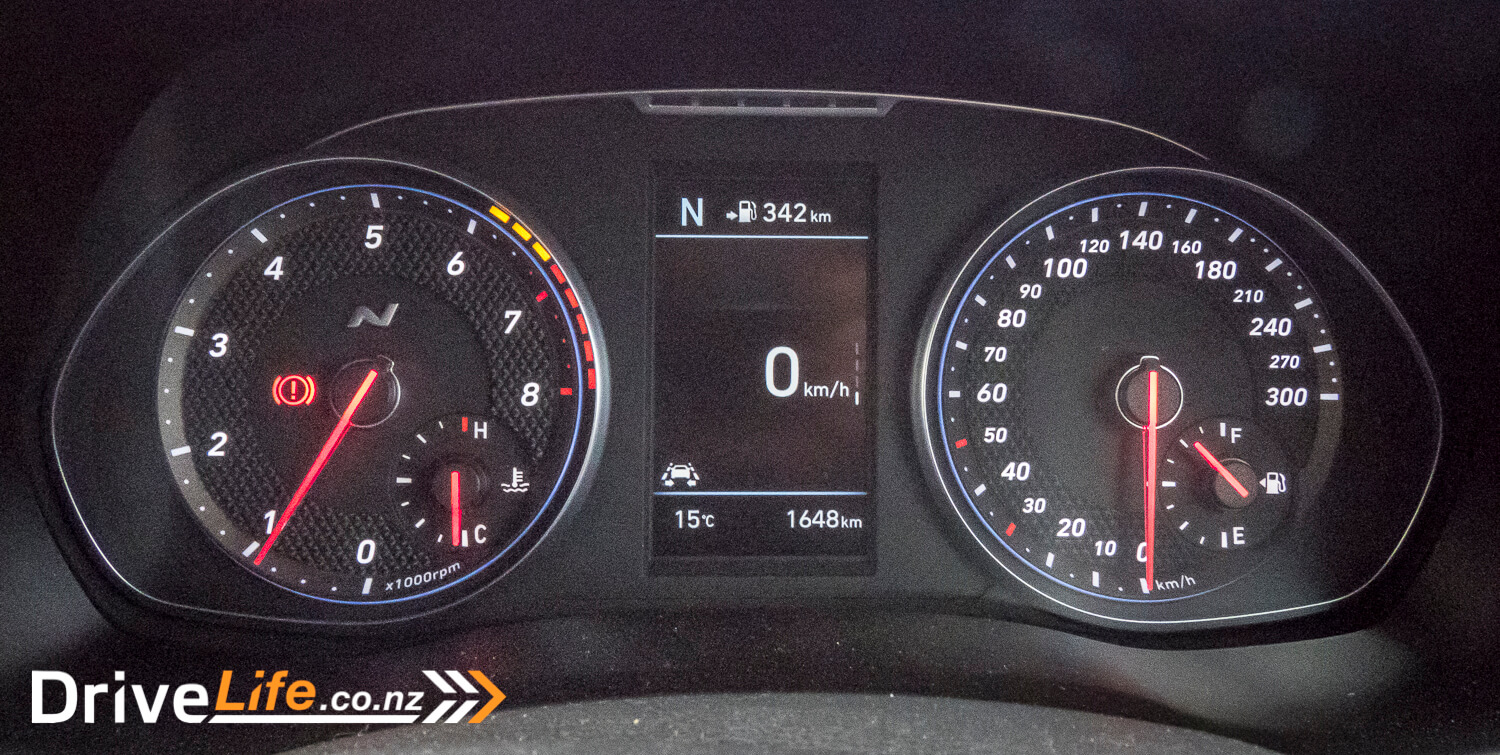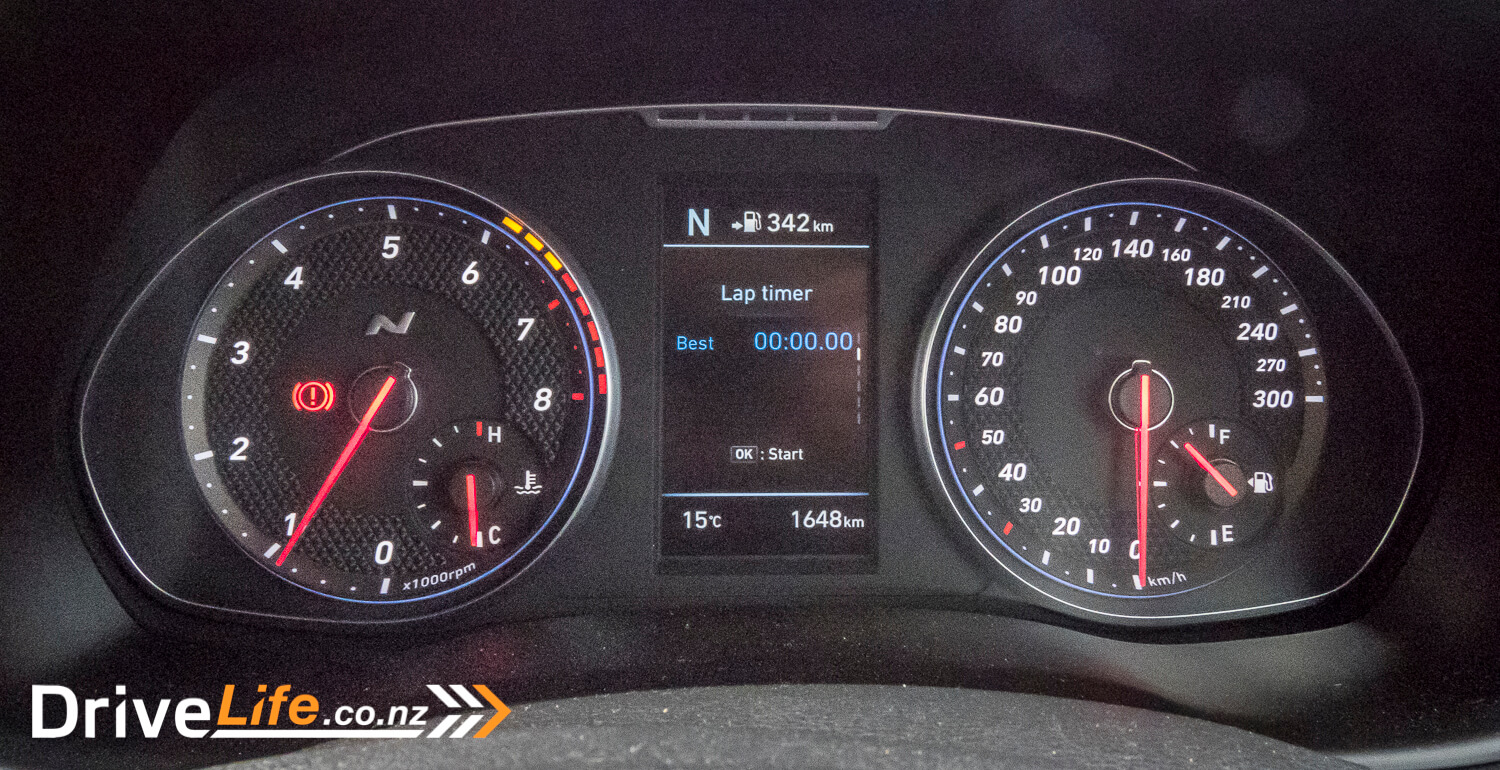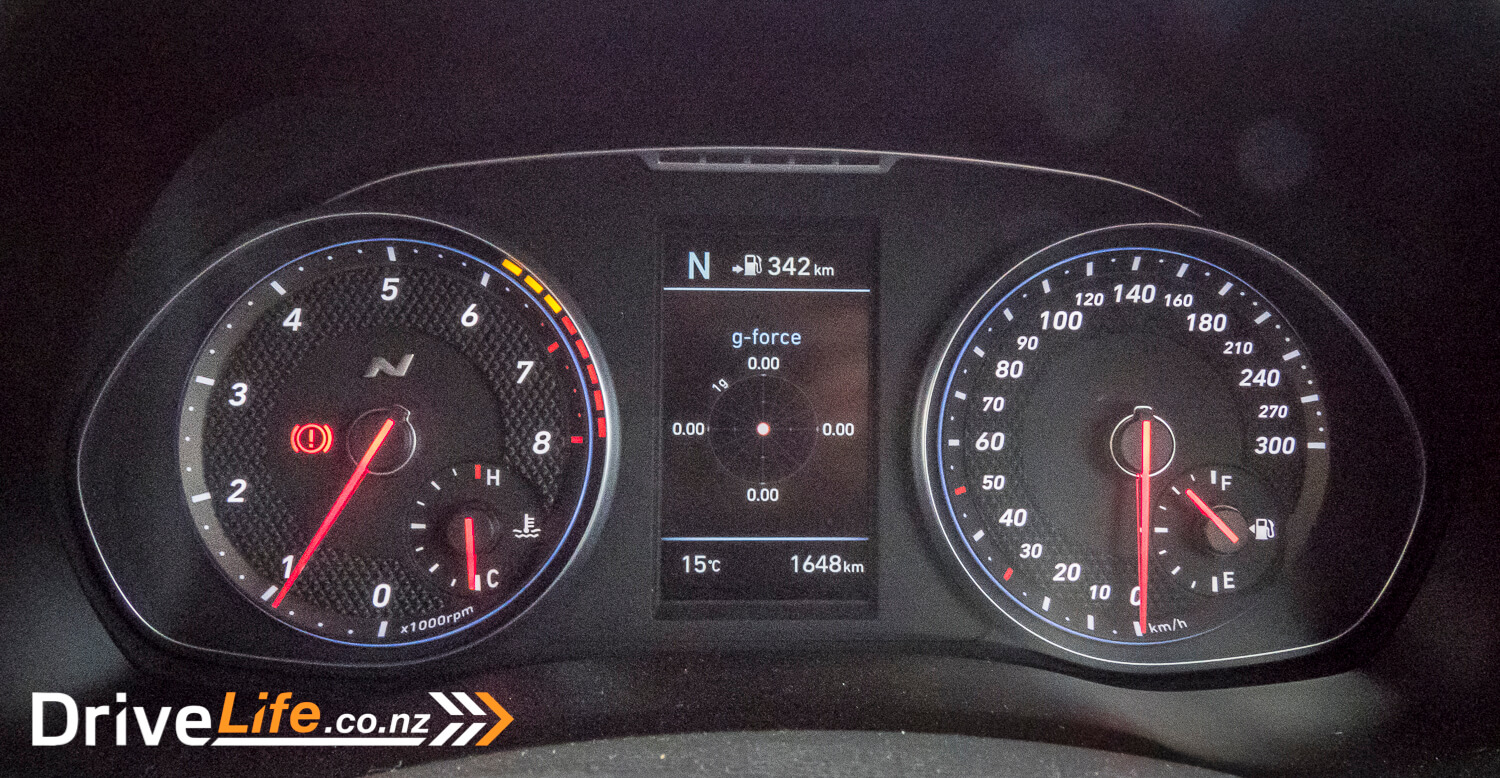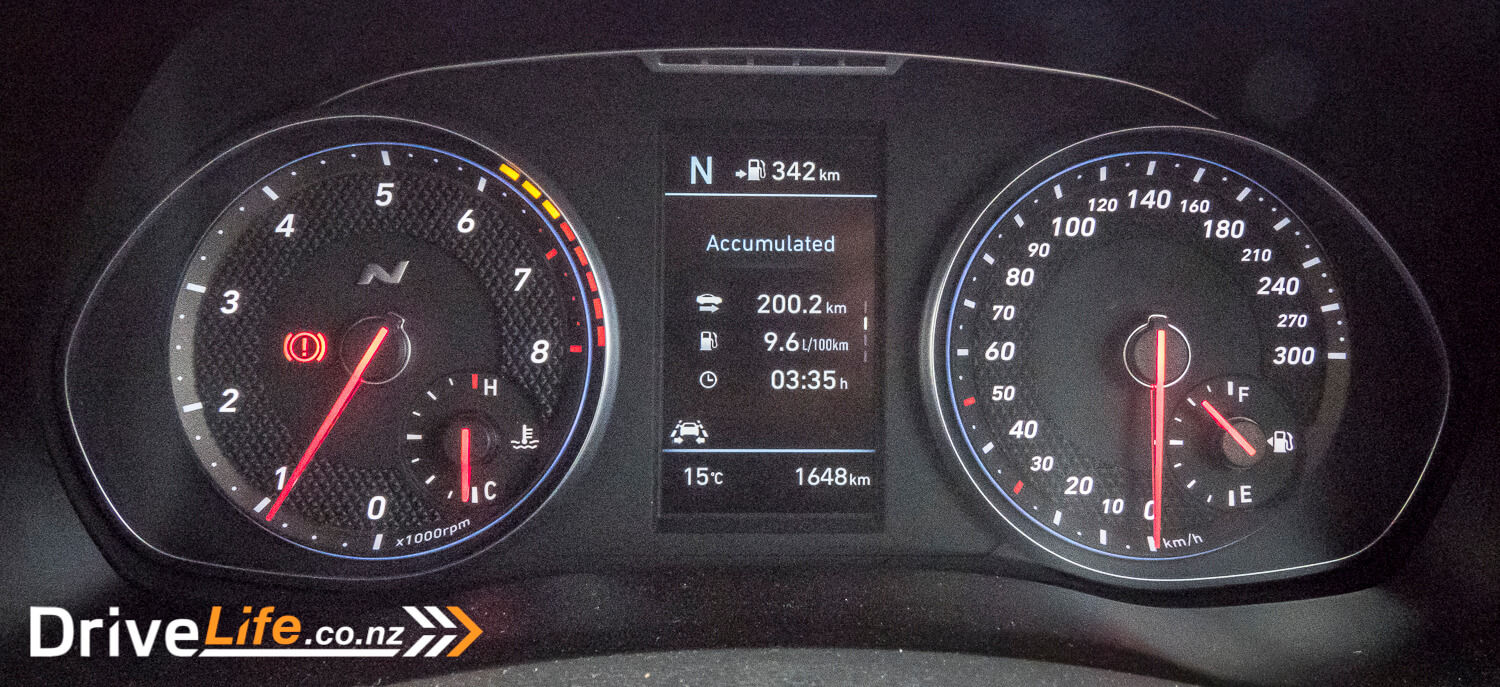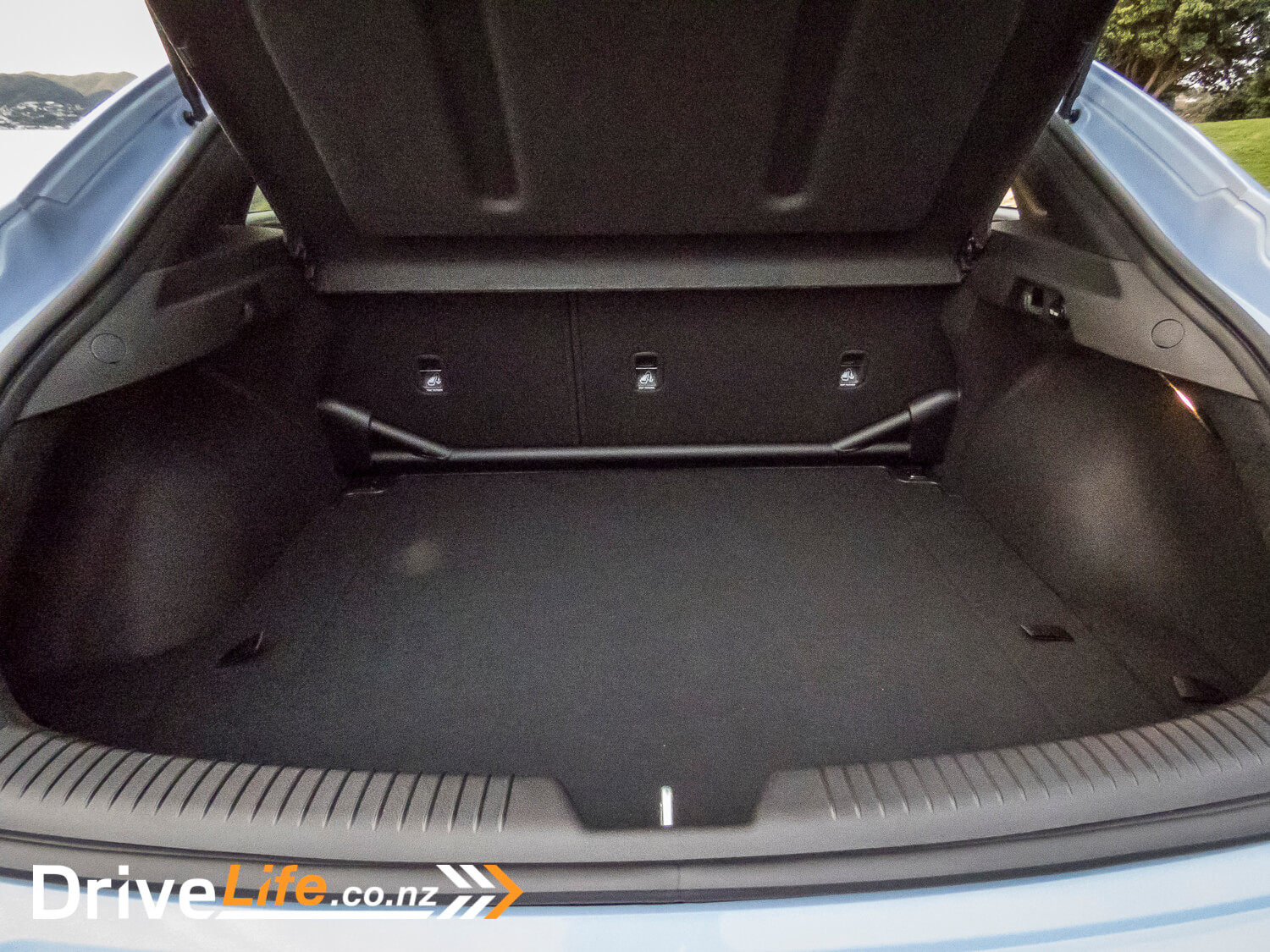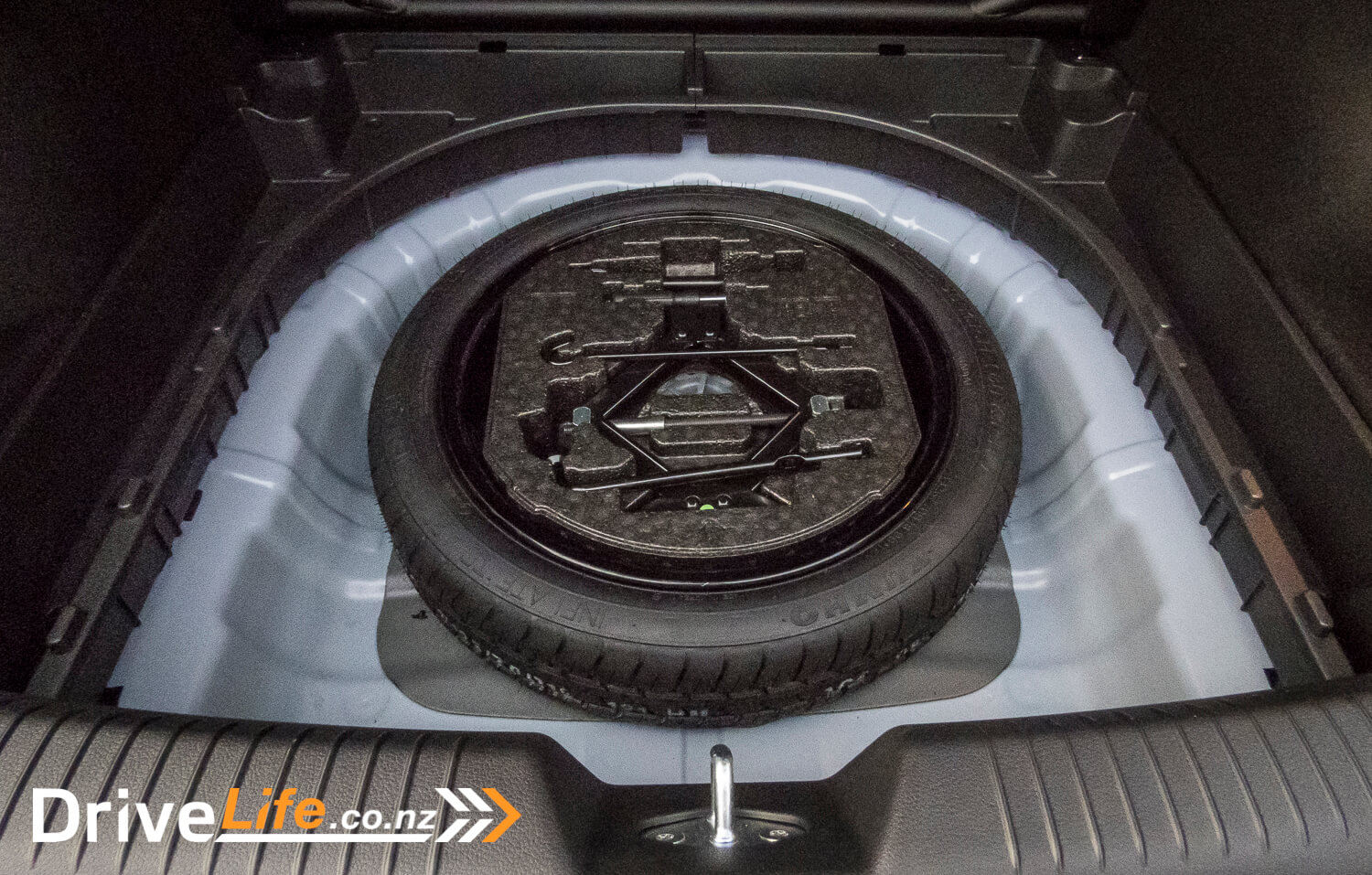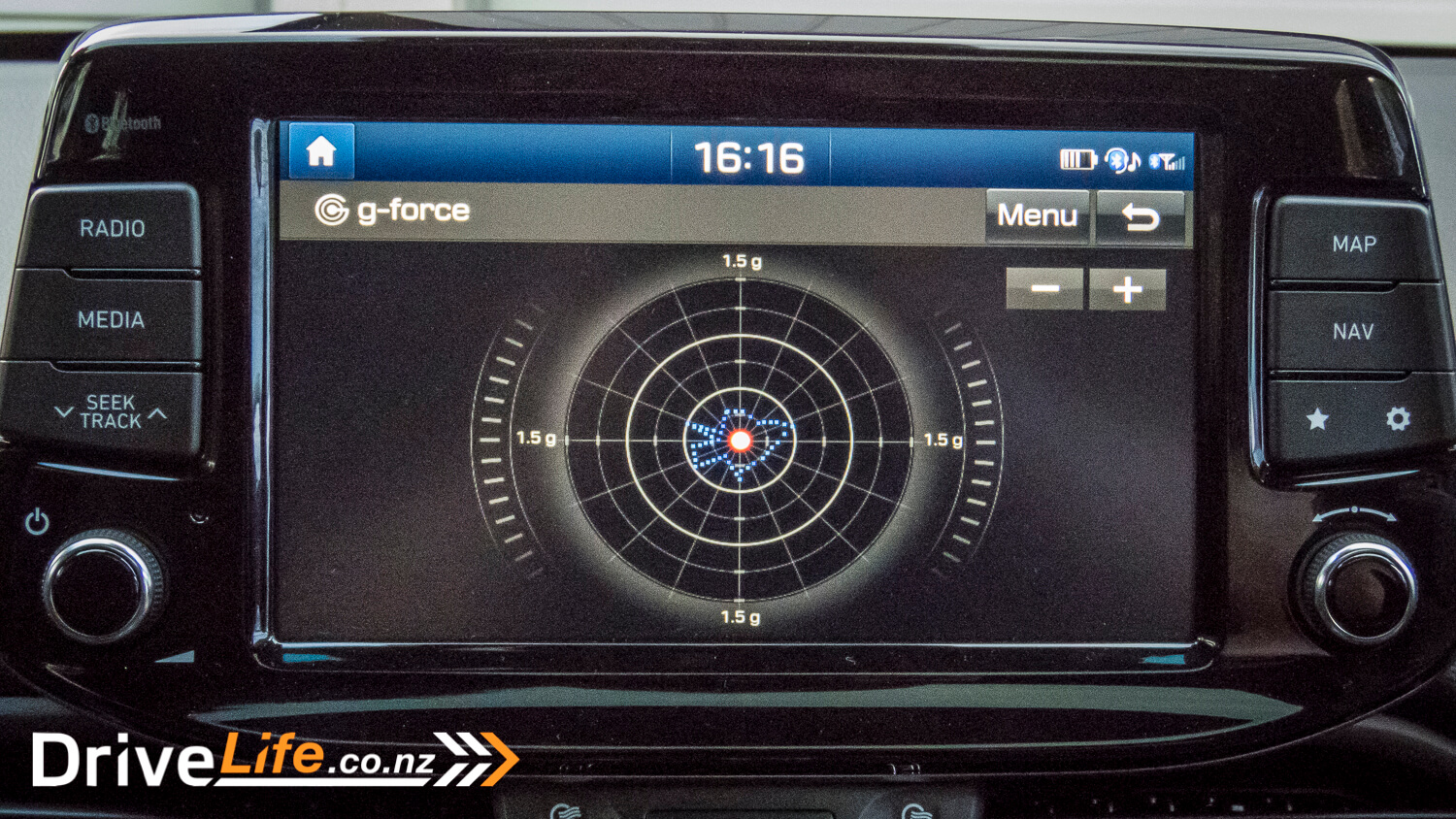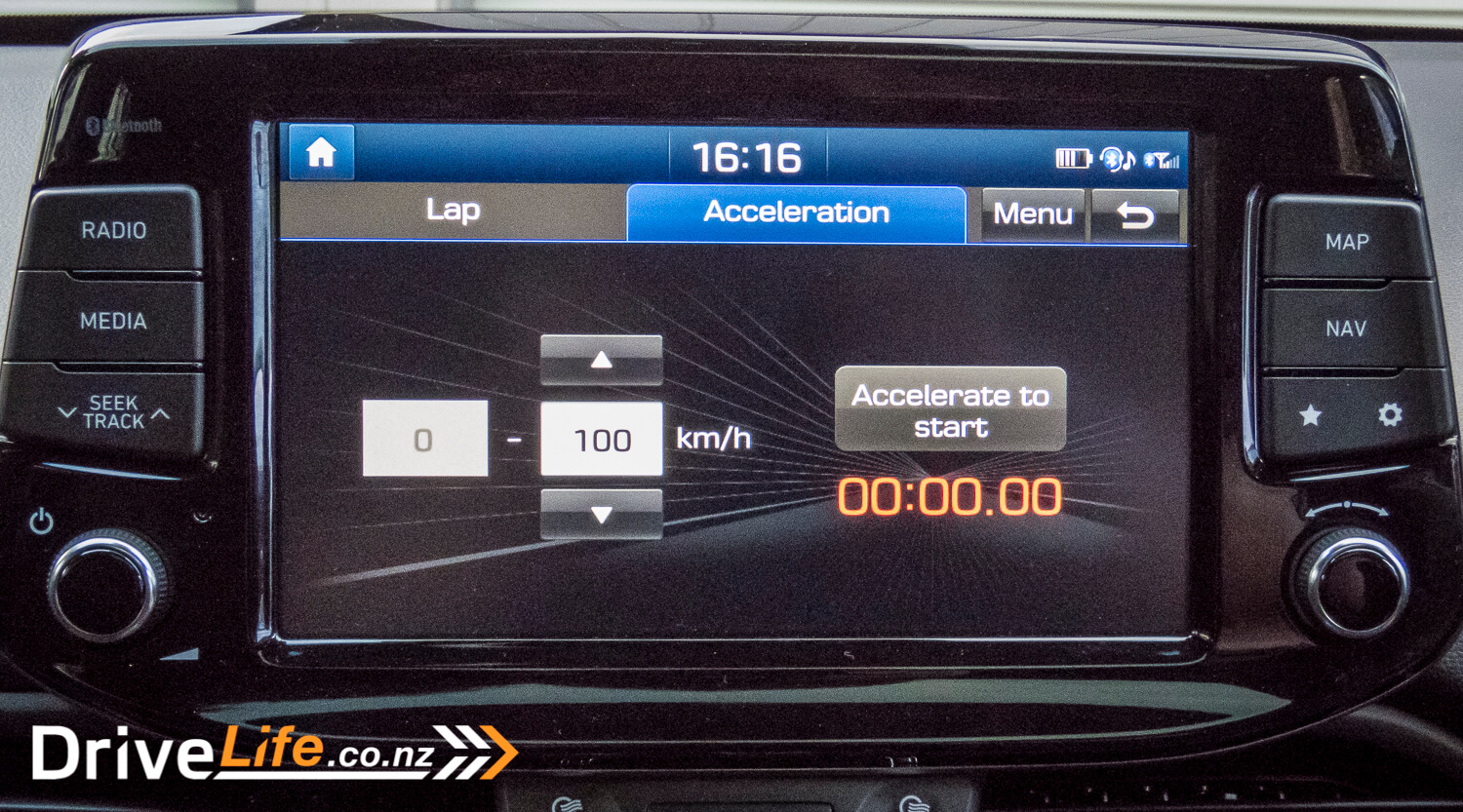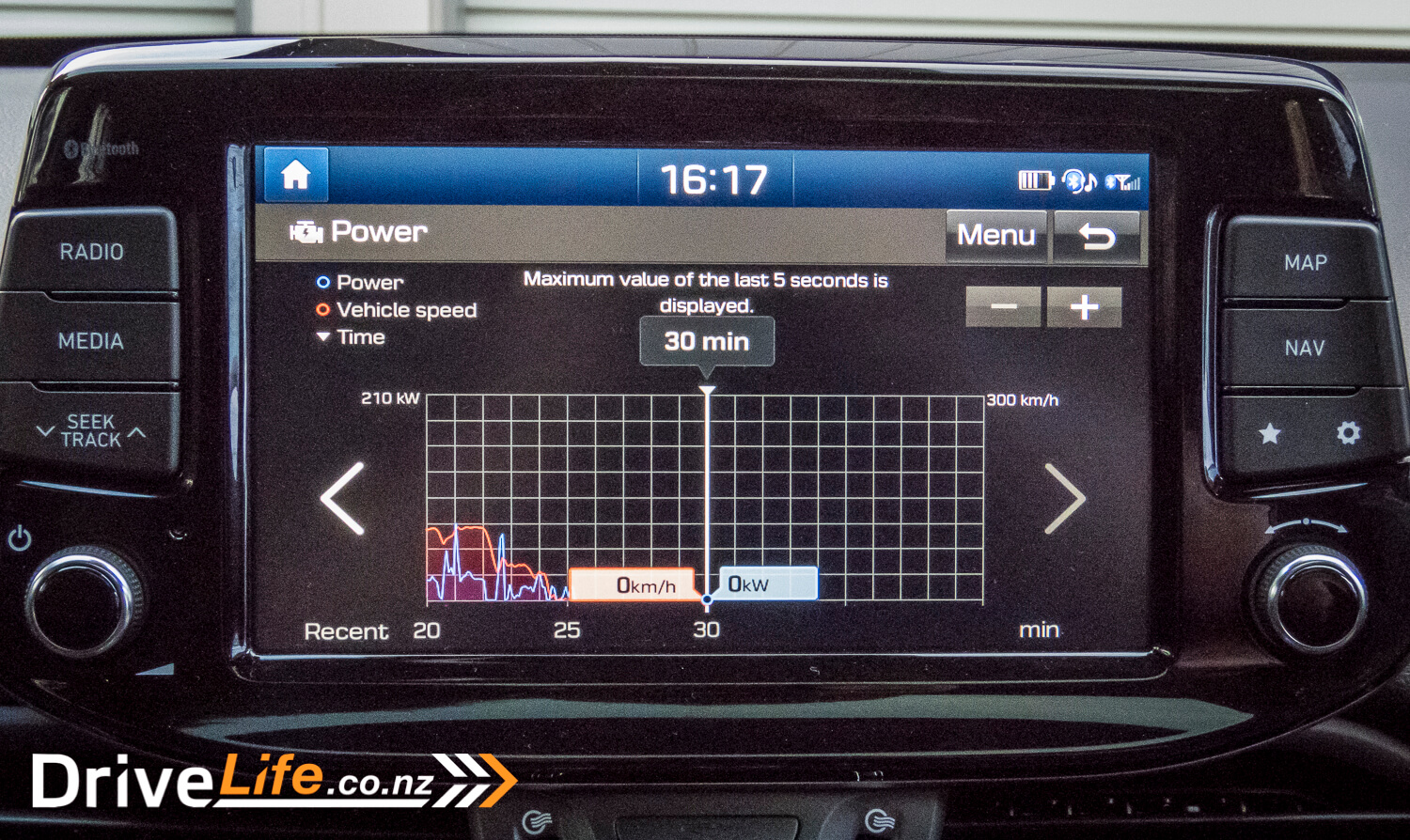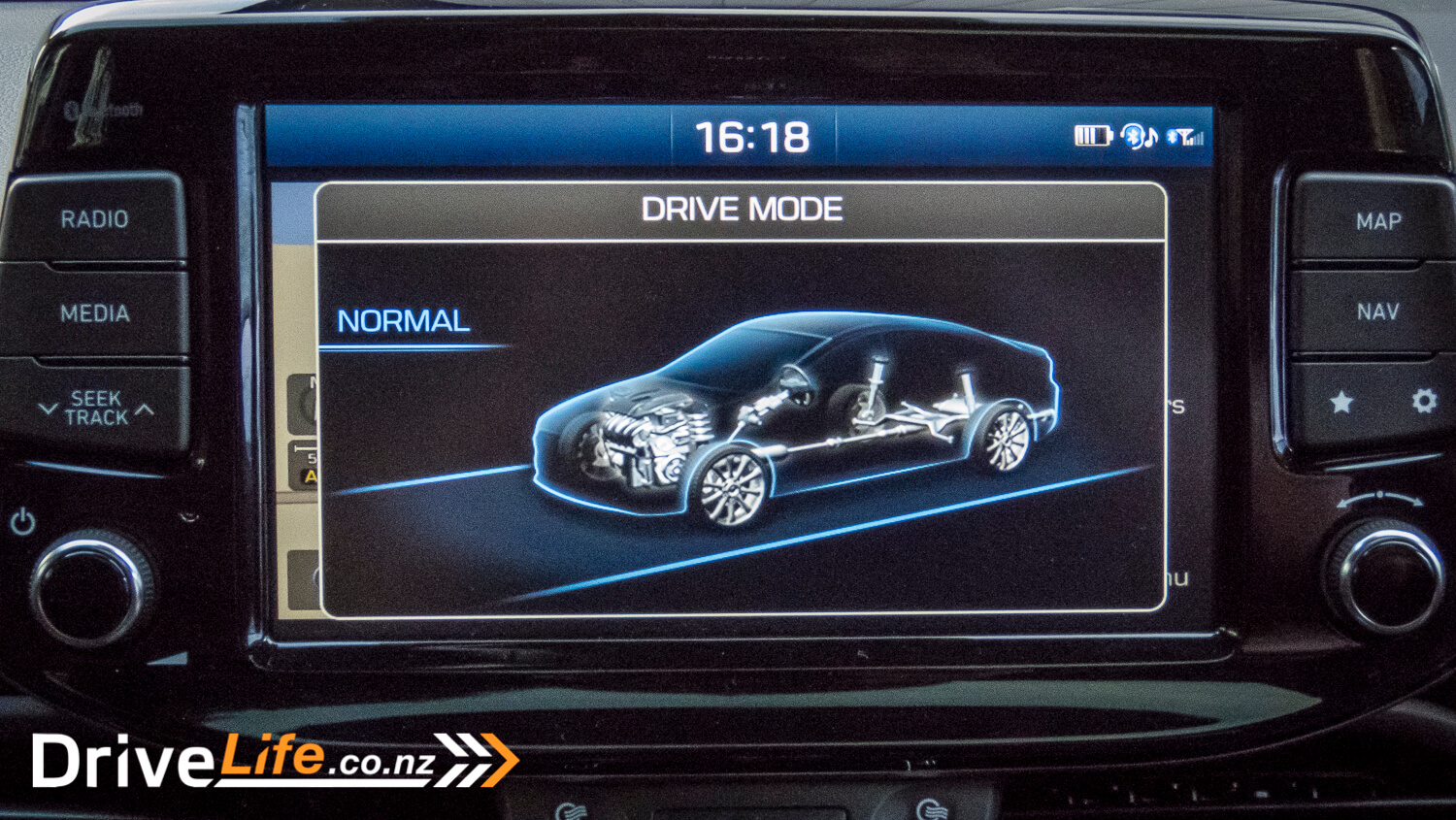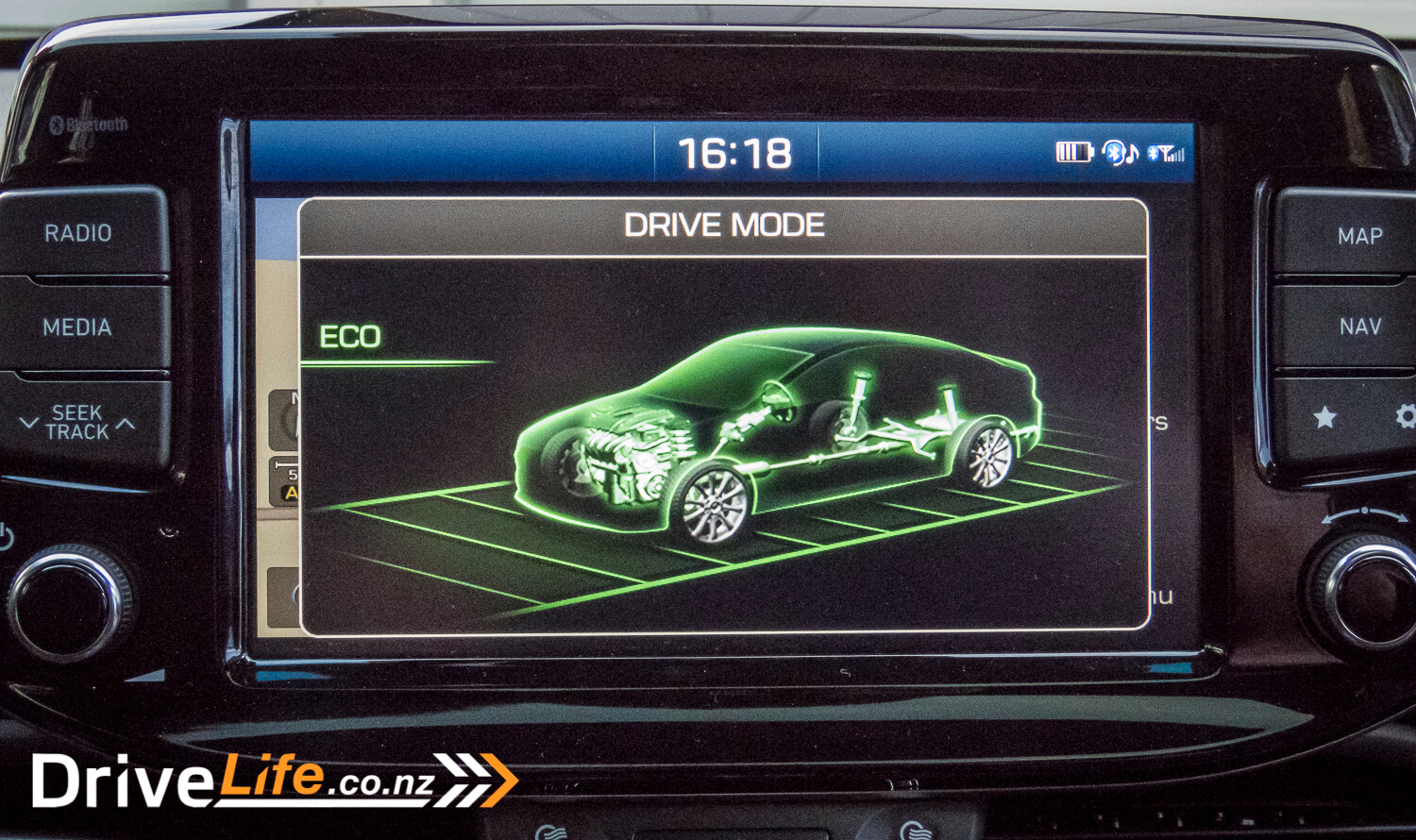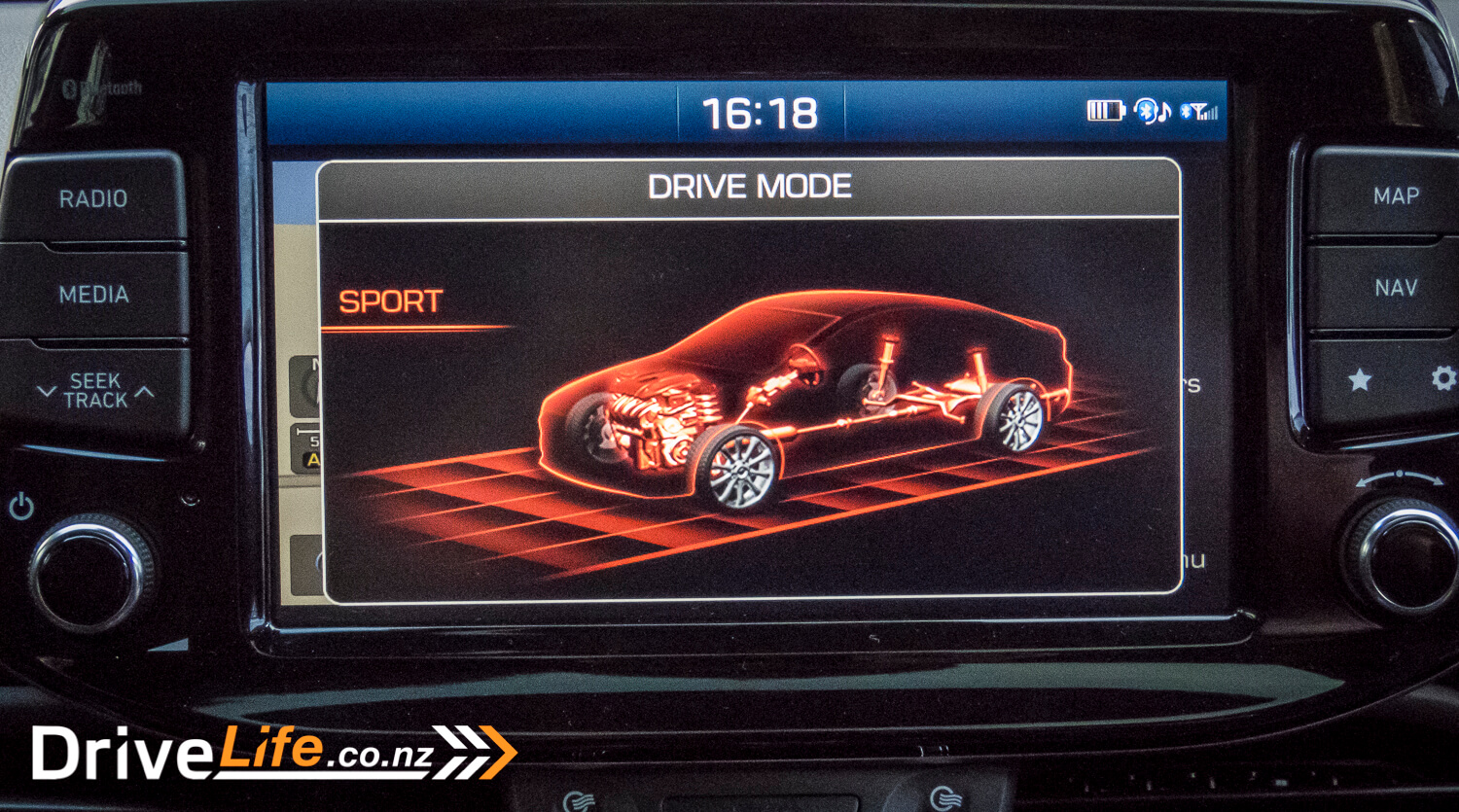The world seems rife with problems. Climate Change. An aging population. Shifting economic powers. Astronomical asset prices. A global pandemic. The Kardashians are a thing. The fact all these issues exist simultaneously is a bit insane.
And this is before we arrive at the problems facing the motor industry. Will petrol-powered performance vehicles be leaving us? Is the demise of the manual transmission imminent? Are there any attainable performance heroes left?
Fortunately, there are some manufacturers still thinking of the car enthusiast. But if you’d told me 5 years ago that one of those brands was going to be Hyundai, I would have given you a funny look.
Yet, history speaks for itself. We know by now that Hyundai knocked it out of the park when they released the i30N hatch. The young upstart quickly gained the respect of its peers when it came onto the scene in 2018, bettering the hot-hatch competition with its driving experience and standard features, while doing so for fewer dollars.
Now, the intern has been promoted, and we have the i30N Fastback. The new car combines the same ingredients as the i30N hatch with minor tweaks, and then packages it in a sleek Fastback design. Needless to say, I was stoked to see this car on my calendar.
It’s my first time living with an i30N. Let’s see how it goes.
What’s In The 2020 Hyundai i30N Range?
Although technically part of the Hyundai’s i30 range, the i30N is better treated as its own entity – akin to BMW and M.
The i30N is offered in two formats, either as a hatchback or as the Fastback. The Fastback is 11kg heavier, and sits slightly lower and on a longer wheelbase compared with the i30N hatch. Otherwise, the specifications are virtually the same across both vehicles.
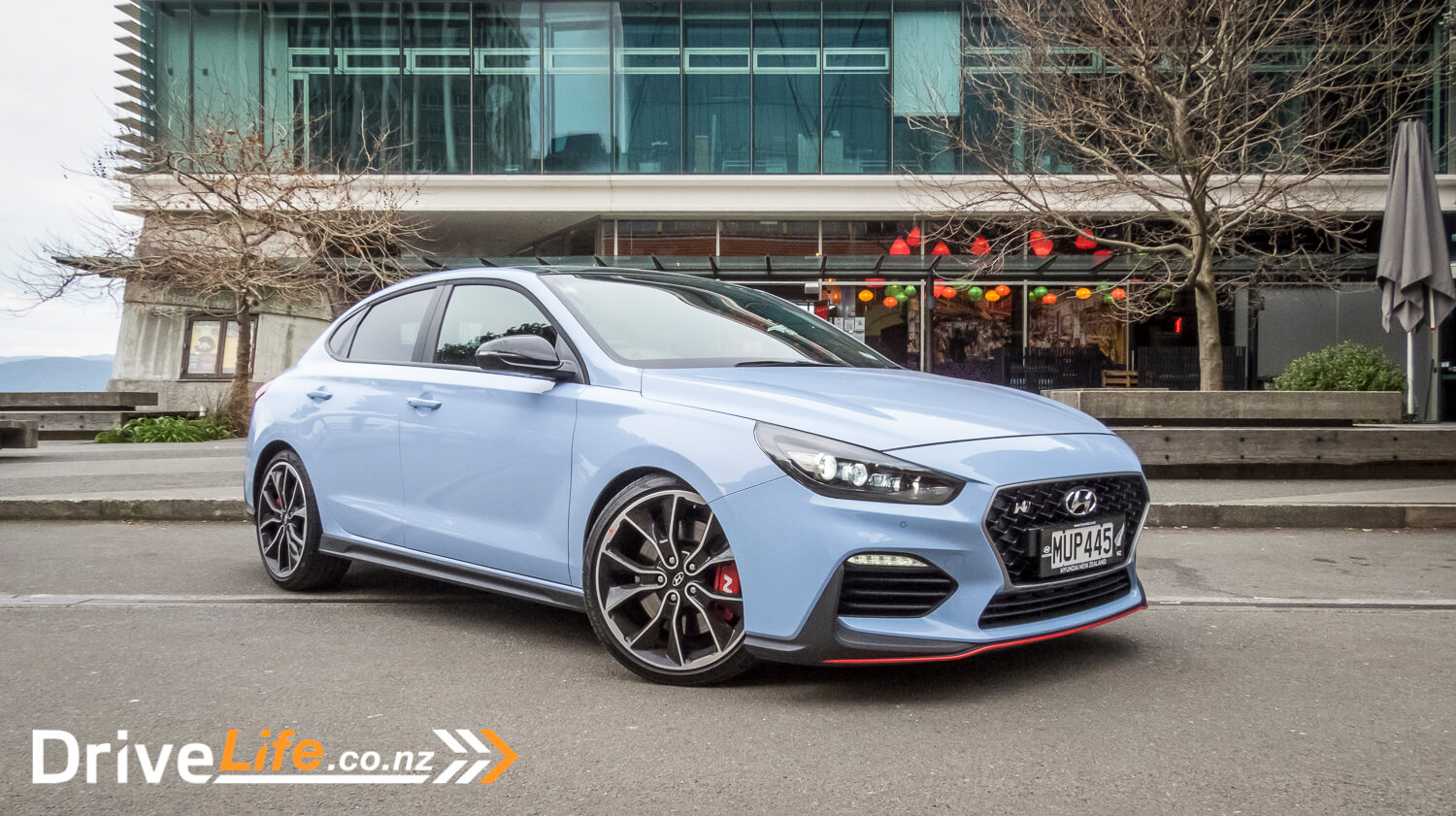
The i30N range is powered by Hyundai’s Theta T-GDI turbocharged 2.0-litre four-cylinder producing 202kW of power at 6000rpm and 353Nm of torque between 1450–4700rpm. The torque figure climbs another 25Nm to a total of 378Nm when the driver reaches peak torque, triggering the i30N’s overboost function. The engine is paired up to a 6-speed manual transmission, with switchable automatic rev-matching.
This combination means 0-100kph in 6.1 seconds, and a top speed of 250km/h.
The i30N is well-equipped for the hot hatch segment, offering a number of standard features, including; an 8’’ touchscreen with satnav, Apple Carplay and Android Auto, dual-zone climate control, alloy pedals, heated sports bucket seats, 12-way adjustable power seats with drivers memory and extendable thigh support, heated steering wheel, wireless smartphone charging, sunroof with power-operated blind, front and rear parking sensors, windscreen auto-defog, cruise control, Smartkey and push button start, rain sensing wipers, power folding mirrors, rear privacy glass, electro-chromatic rear vision mirror, LED front and rear lights with DRLs, LED courtesy and puddle lights, 7 airbags, tyre pressure monitoring, automatic dusk sensing headlights, hill-start assist control, plus Hyundai SmartSense package, which offers; autonomous emergency braking, driver attention alert, forward collision warning, and lane-keep assist.
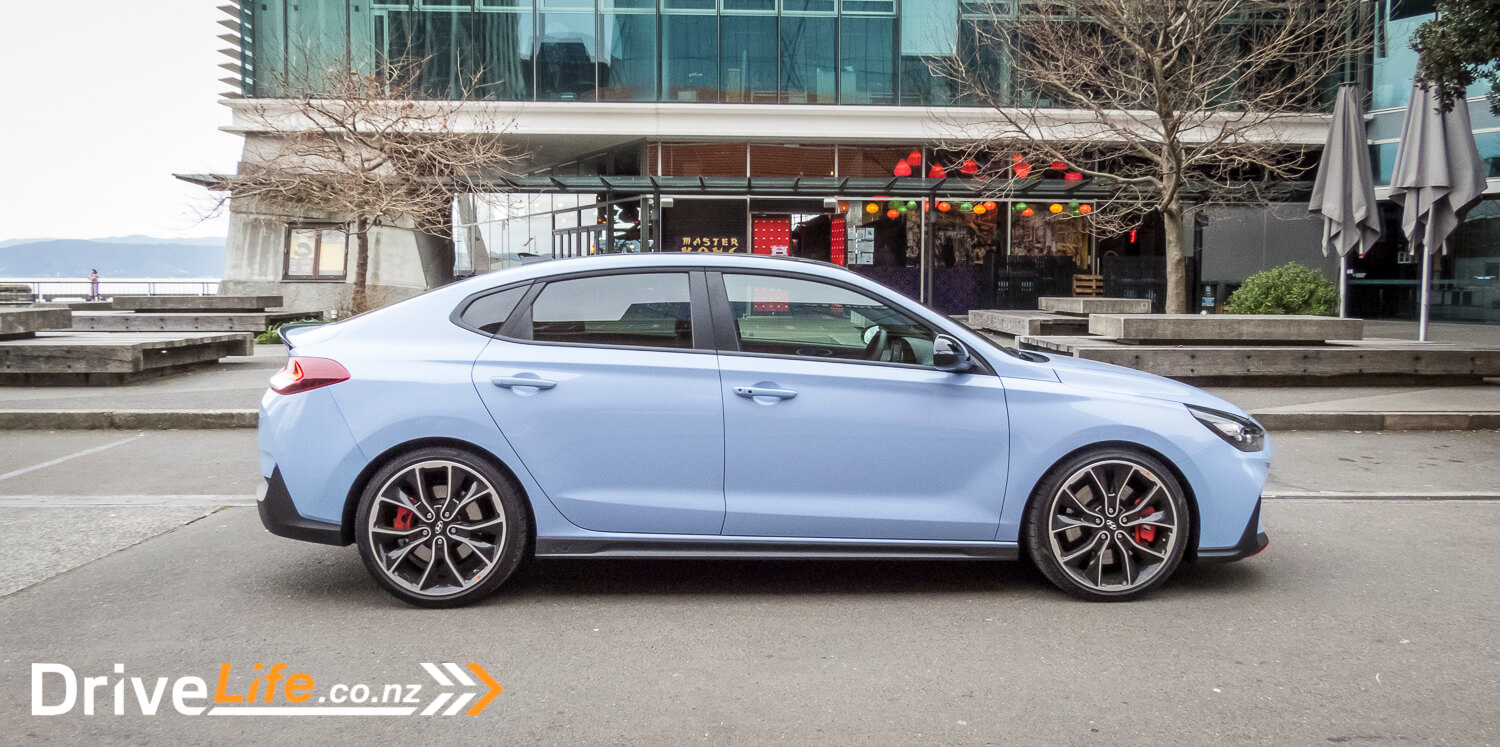
The i30N is also equipped with a number of performance features as standard, including; 19’’ alloys with Pirelli P-Zero HN’s, performance brakes, an electro-mechanical Limited Slip Differential, electronically controlled suspension, an active variable exhaust system, rear strut bar, automatic rev-matching, a configurable N-race computer and drive mode system, and the all-important Launch Control.
The i30N Fastback is available in 6 different colours, including Polar White, Phantom Black, Micron Grey, Engine Red, Performance Blue, plus a further offering exclusive to the i30N Fastback, Shadow Grey.
The i30N Fastback starts at $59,990, while the i30N hatchback starts at $54,990. You can read up on the full specifications on Hyundai New Zealand’s website.
First Impressions Of The 2020 Hyundai i30 N Fastback
The i30N hatchback has always been a handsome design, but when I saw the Fastback in the flesh for the first time, I was immediately sold.
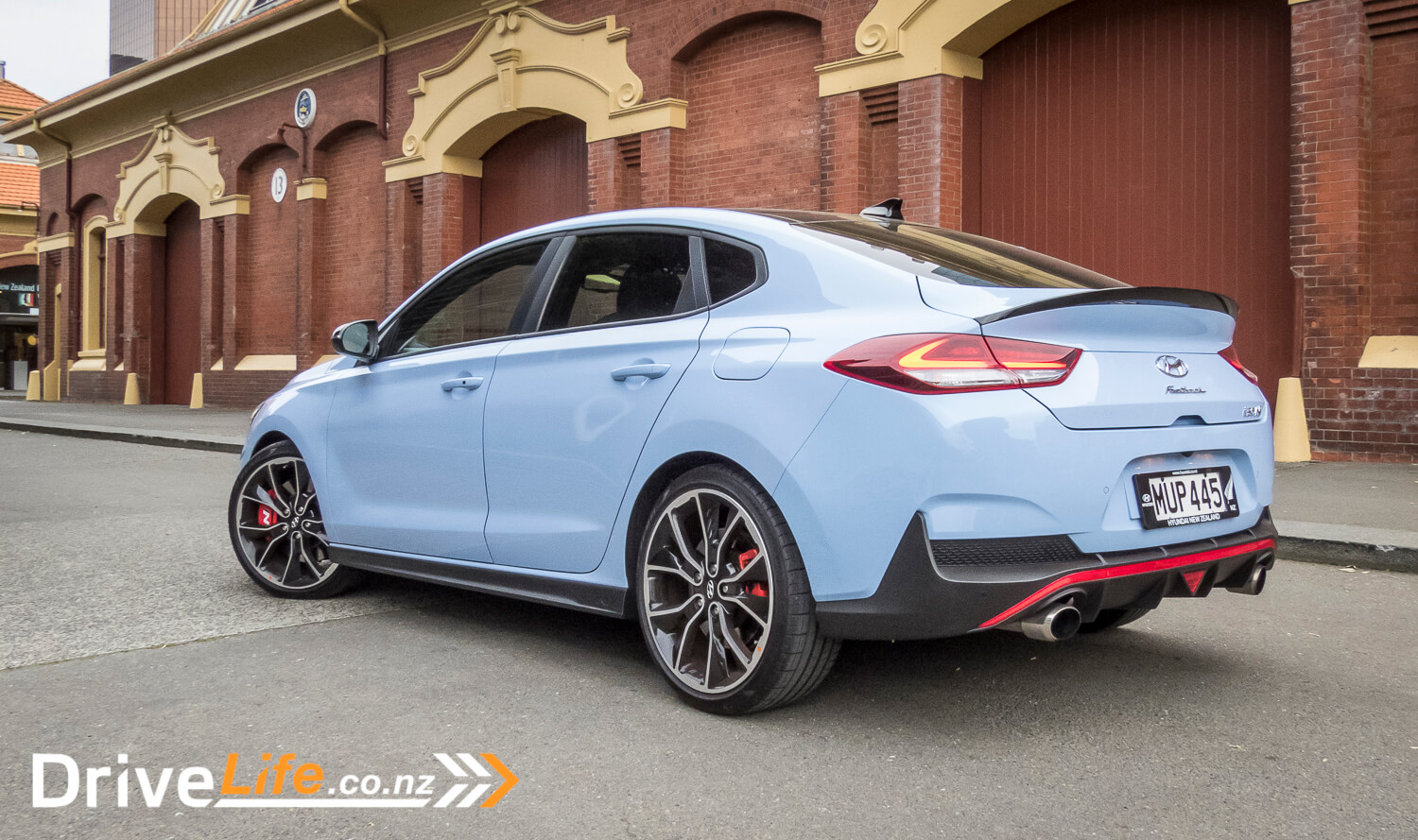
The Fastback sits slightly lower and longer than the hatch. The styling maintains the staunchness of the original, whilst appearing sleeker and more matured. I also love that the i30N Fastback is now unique amongst its competition and better differentiated from the rest of the i30 range. As good-looking as the i30N hatch is, it always seemed more subtle amongst a crowd of hot hatches which are often defined by their flamboyance (I’m looking at you, Civic Type R).
The Fastback gets all the special N-touches, such as the 19’’ alloys, with red brake callipers emblazoned with the N logo shining through underneath. There’s red trim across the front lip, plus black side-skirts, again adorned with the N-logo. Around the back, there’s a discreet ducktail style spoiler unique to the Fastback, finished with a gloss black trim. The rear bumper is also fresh design, while still incorporating the triangular fog-light and the normal twin exhaust set-up. The new rear daytime running light (DRL) design also really gave an edge to the Fastback.

Above all, it was those rear LEDs and the Performance Blue colour which sealed the deal for me.
Overall, I feel that Hyundai deserves some proper kudos for design of the Fastback. There aren’t many manufacturers that can pull-off modifying an existing body-design, and manage to make it look this good.
What’s The Interior Like On A 2020 Hyundai i30 N Fastback?
Walking up to the i30N, the car introduces itself to you by automatically unfolding the wing-mirrors and illuminating the ground with mirror mounted LED lights.
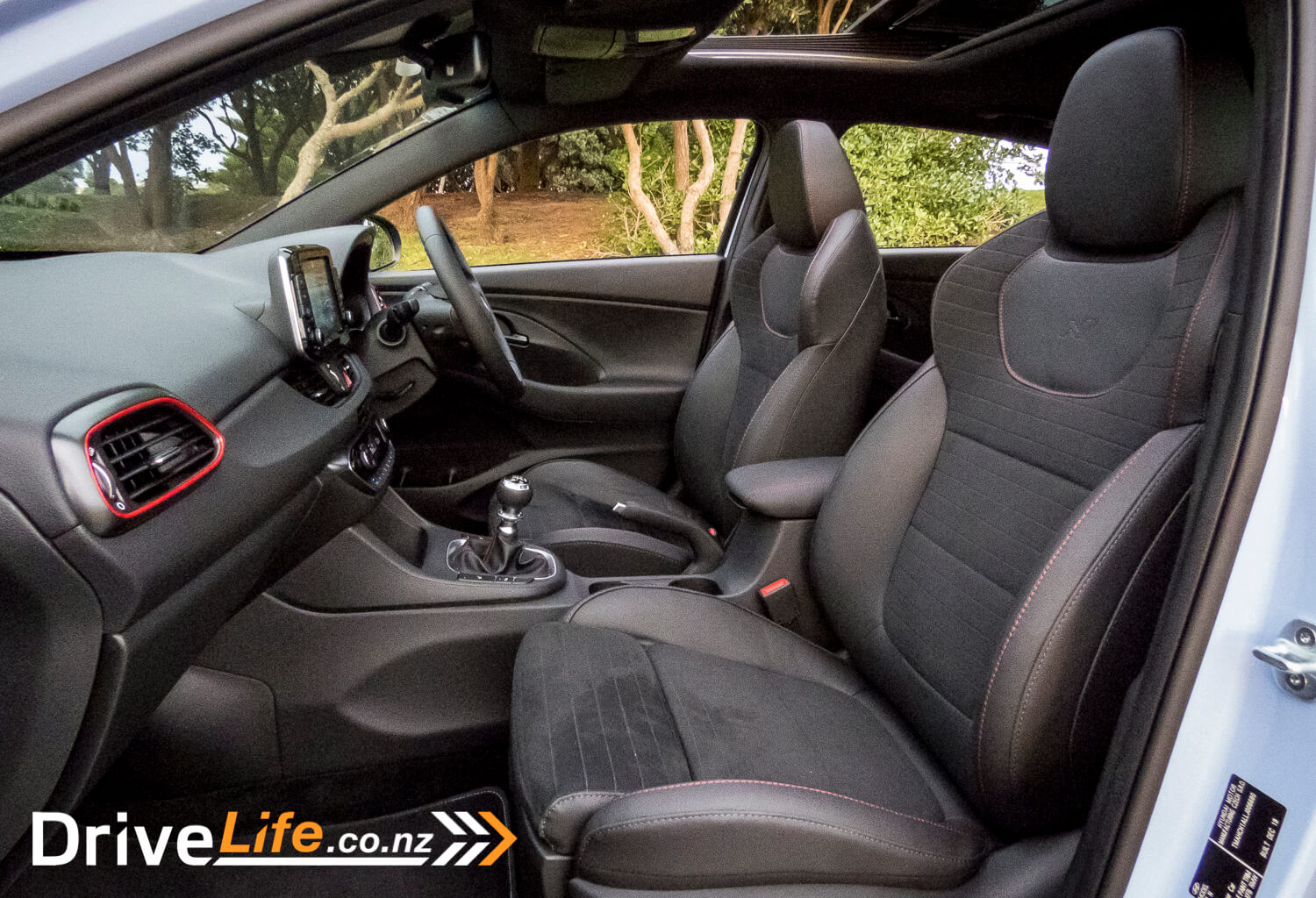
Stepping inside the i30N, you immediately place yourself onto the i30N’s excellent sport seats. The seats are layered with alcantara and leather, completed with red contrast stitching. Both the driver and passenger’s seats are electronically adjustable, with the driver’s seat offering 12-way adjustability and two memory settings. The seats are also heated, and offer adjustable lumbar and under-thigh support.
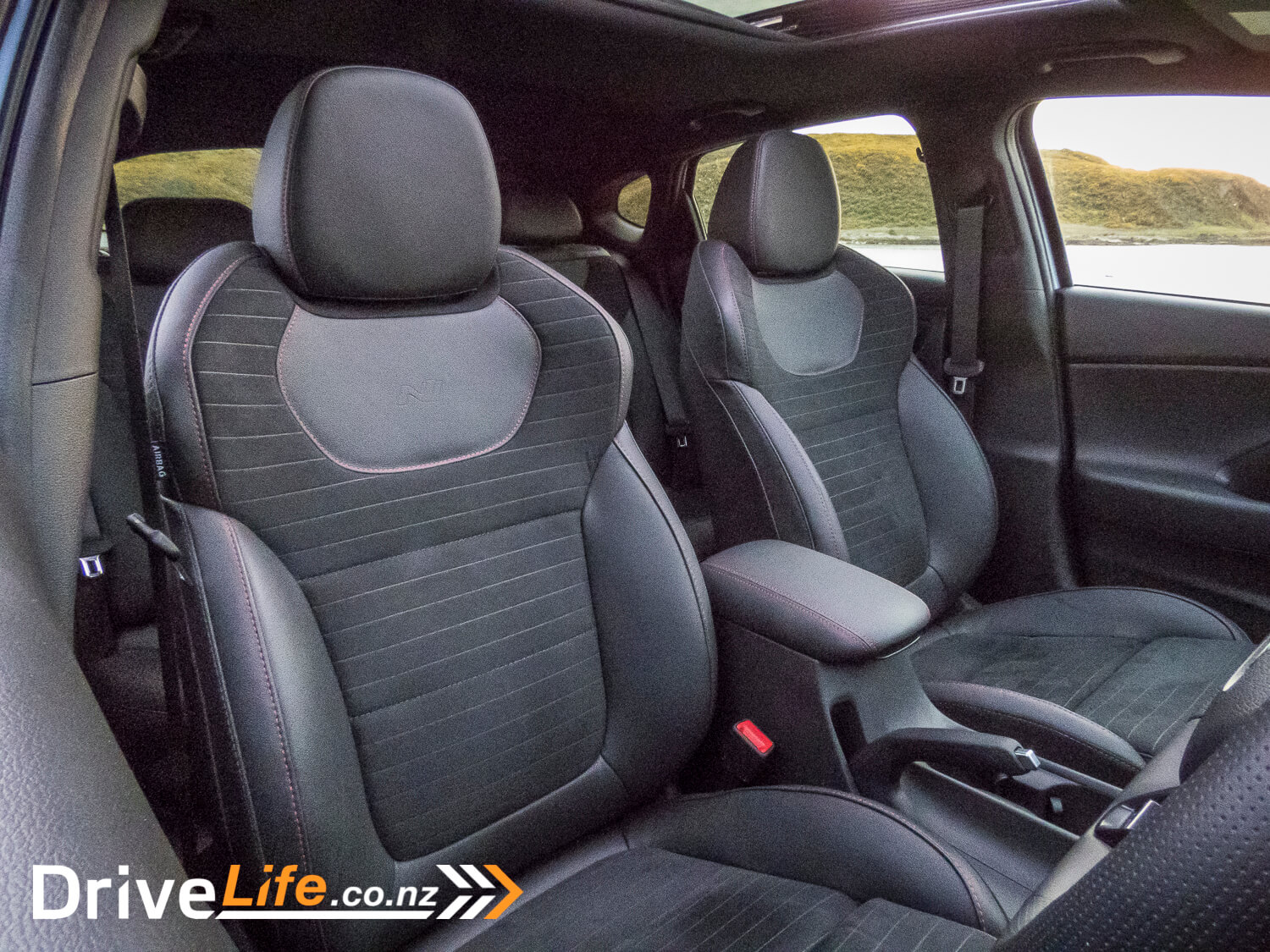
Personally, I thought the seats themselves were near perfect for a performance hatch. They’re bolstered enough to hold you in-place on spirited runs, while also being comfortable and supportive enough for a long drive. This, plus the use of leather and alcantara materials makes it feel like you’ve nested yourself into something high-end.
Once you close the door, the driver’s seat automatically whirrs forward to the last driving position. Open the door again and it whirrs back to allow ease of egress. This feature is good for climbing in, but it takes a bit too long to move back when you’re climbing out.
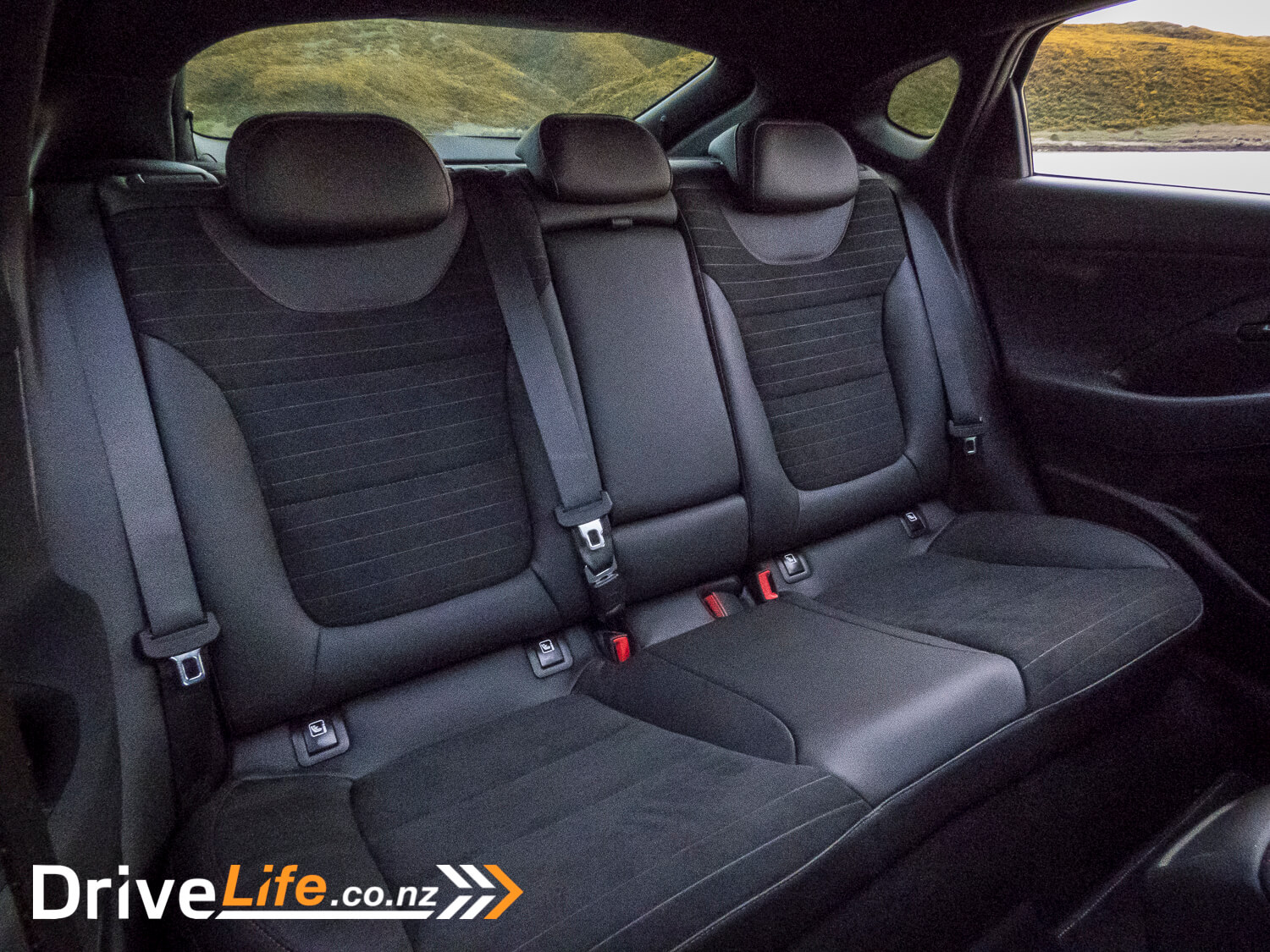
The steering wheel is leather wrapped and continues with the red contrast stitching. The wheel thickness was spot-on, but it was a bit wide for my liking. The steering wheel is also heated, which is one of those ‘once you’ve had a taste’ features, that you’ll sorely miss on vehicles without it. Button wise, the layout is similar to the rest of the i30 range, with some noteworthy exceptions. This includes the two large, drive-mode selector buttons. More on this later.

The gearstick is a blend of aluminium and leather giving it a premium and robust feel. This, and the alloy pedals are among many of the special touches inside the i30N.
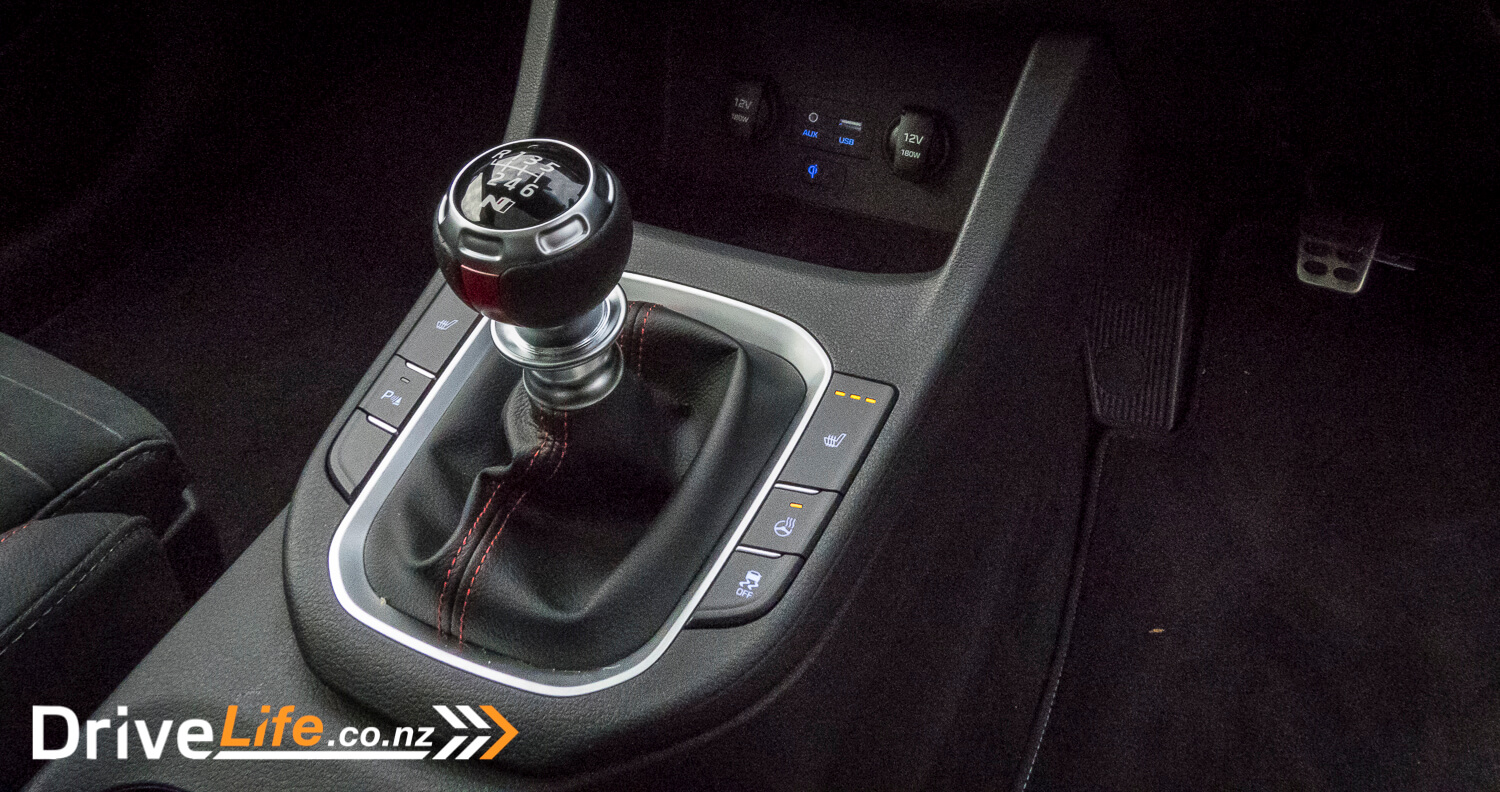
Looking forward, you’ll find a clean dash cluster arrangement with a configurable centre driver’s display which shows everything from the tyre pressures to the g’s you’re pulling through a corner. Above the tachometer are a series of red LED bars, showing the redline range on the i30N. Starting the i30N, a series of orange LED bars will precede them to show the max recommended rev range while the engine is cold. The lights around the tach reminded me of those used on an BMW M5 (E39), which is a subtle hint about the engineering expertise Hyundai has employed in designing the i30N. Above the centre display are a series of integrated shift lights, which flash on when you start driving like you’re meant to.

Start looking around the cabin and you will notice some of the i30N’s economy car roots. The dashboard layout is identical to the rest of the i30 range, meaning there’s a fair amount of hard plastic around the cabin. The infotainment is stuck-on the dash, front and centre, which seems on-trend in the automotive world.
There are a few accents to give away that you’re in something a bit special, such as the red anodised trims on the climate vents, which provide a racy visual lift in an otherwise conservative interior. Below the climate controls are two 12-volt outlets, a USB port, an AUX port, and another modern-day luxury, a wireless phone charger. There’s even an on-dash reminder to tell you if you’ve left your phone in there once parked.
Given all the black materials throughout, it can get dark inside the cabin. This is easily resolved with a push of a button, which rolls back a shade to reveal the large panoramic sunroof. I genuinely don’t understand why Hyundai never offered a sunroof on the i30N hatchback when it first launched in New Zealand, because sunroofs are awesome! The only downside to the panoramic roof was that I found the square shaped control button a bit fiddly to use. I couldn’t quite work-out how to only have the sunroof in tilt mode without first fully opening it.
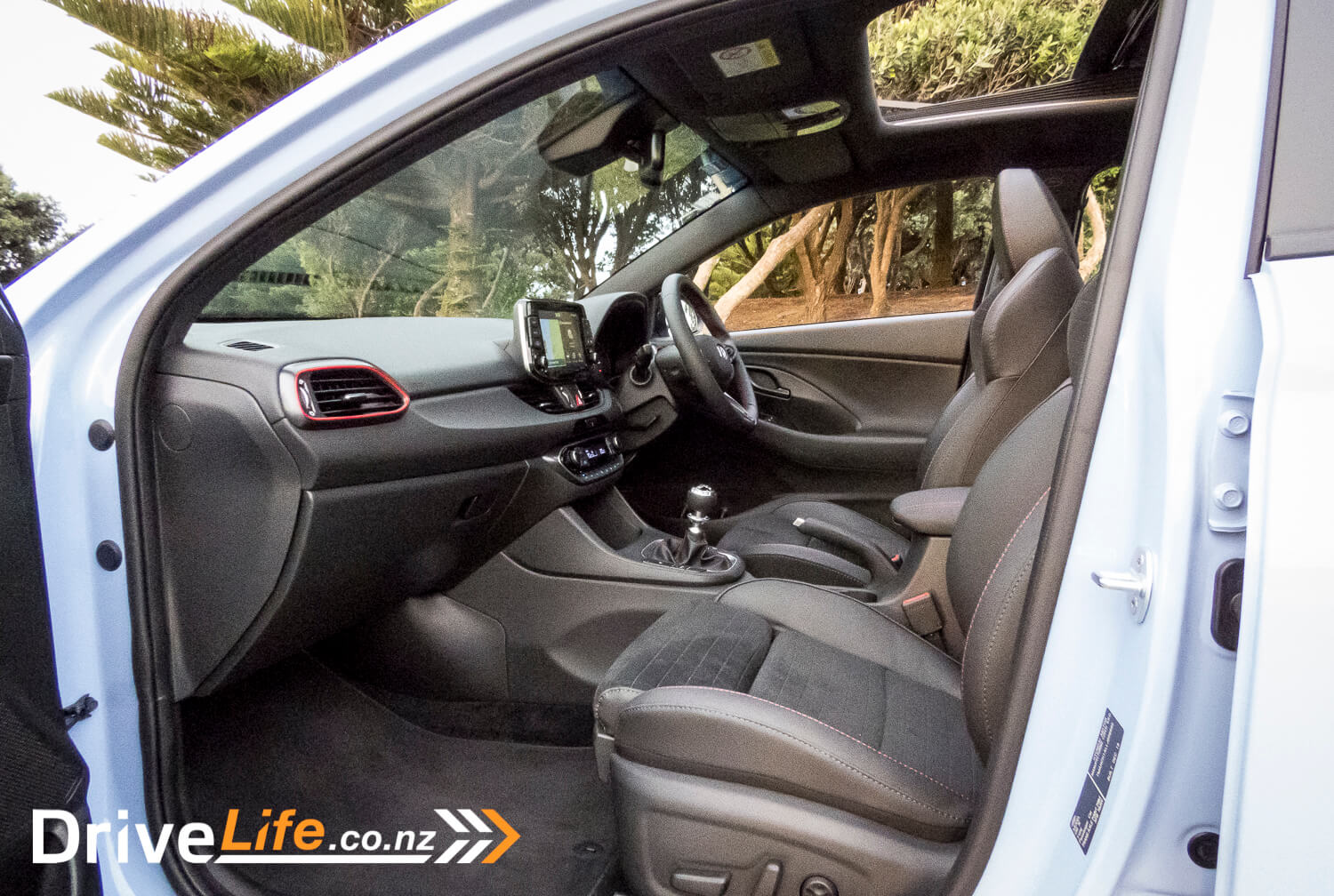
So far so good then? Absolutely. Although, it’s virtually the same interior between the Fastback and hatch. However, the design of Fastback does present it’s own quirks.
One main compromise of the good-looking Fastback body is the visibility. The blind-spots weren’t too bad, though the rearward visibility was the main complaint. The rear window has a serious pitch, making your perspective looking-out the rear quite awkward.
The tapering roofline is also another story for rear passengers. The back seats themselves are comfortable and offer an acceptable amount of leg-room. However, these seats will be reserved for the vertically challenged. I’m 5’11, and my head was touching the roof in the rear. If you’re prepared to slouch, you can make it work. Just make sure you don’t go any speed bumps too quickly.
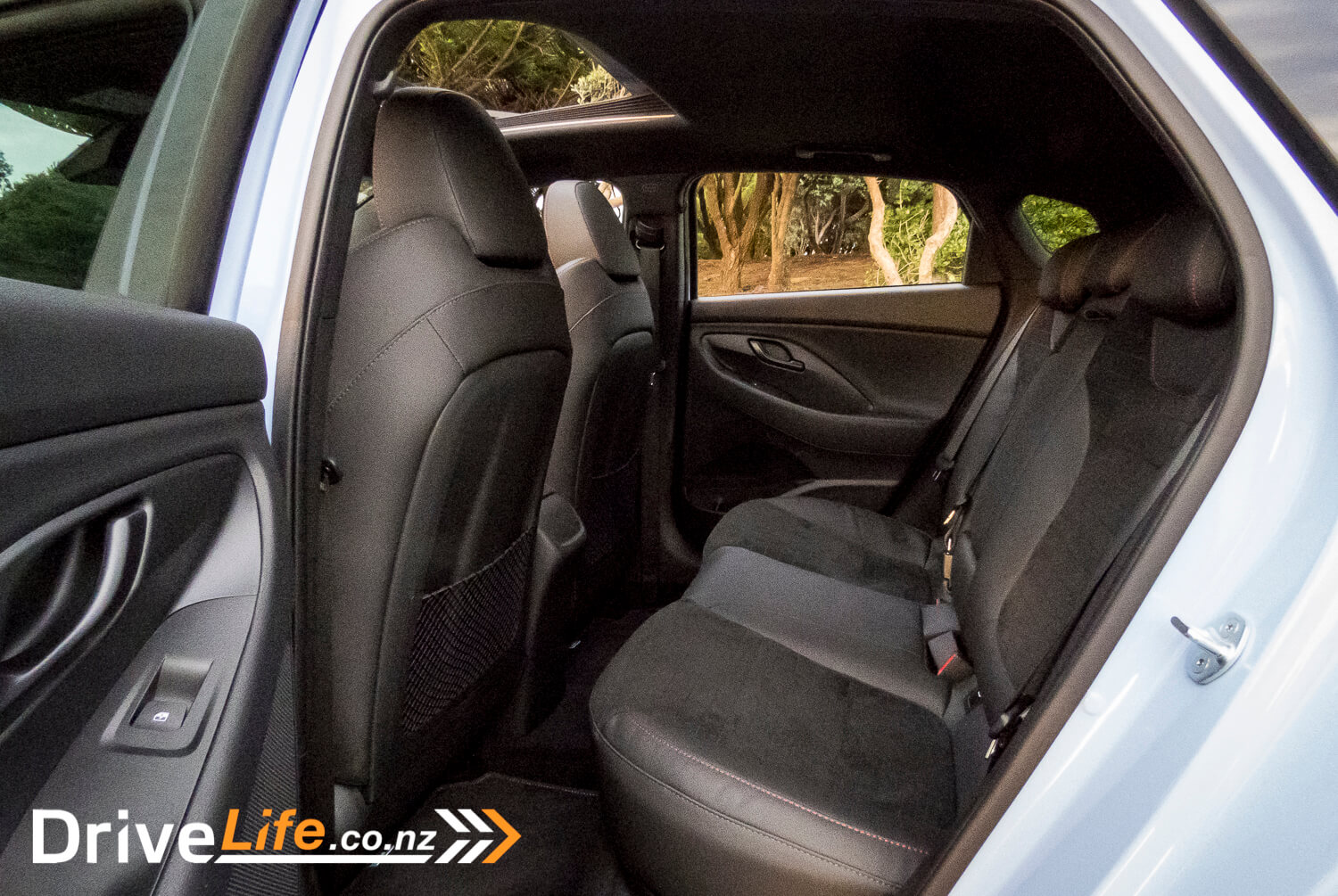
Despite the compromised rear headroom, the Fastback does lend itself to a very generous boot. Up to 436 litres with seats up, and 1351 litres with the seats down. There are crossovers that’d be jealous of those numbers. The space is otherwise quite practical, except for, well, the rear strut brace that’s mounted back there.
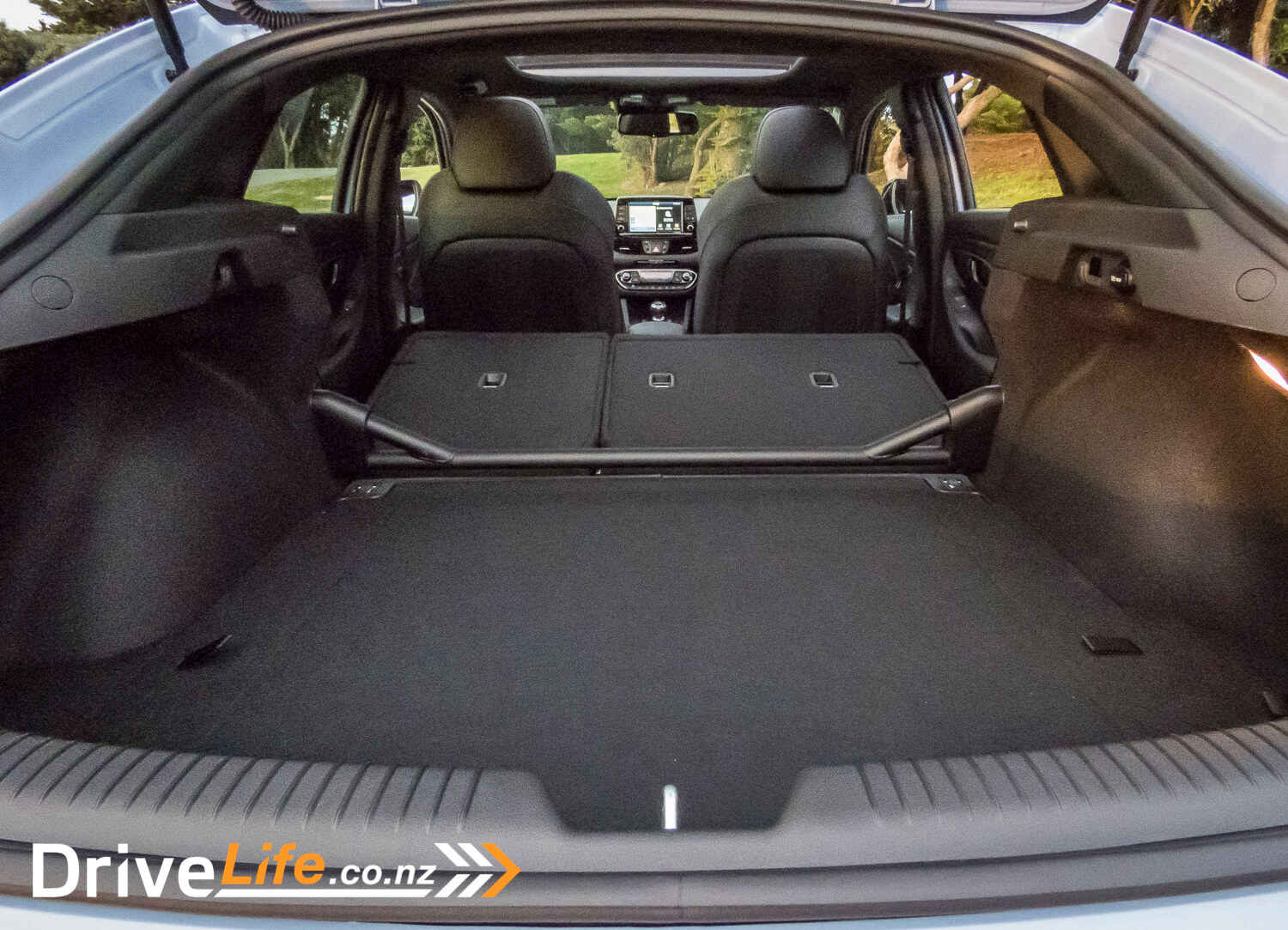
Although, I need to give Hyundai some credit here. In reality, the strut brace is almost a non-issue with the rear seats up. The brace sits almost perfectly behind the back of the rear seats, only impeding the space when you put the rear seats down. You’ll then need a socket set to remove it. Hyundai has done their best with the design where the bar sits as low as possible to the floor, before connecting up to the strut tower. However, the i30N’s competitors such as the Civic Type R, manages to go without one.
I should be clear; this rear strut base is present on both the hatch and Fastback, therefore it’s not a body-specific issue. Otherwise, the strut bar is Hyundai signalling their priorities with the i30N, which I think is pretty cool.
Technology wise, the infotainment is standard offering from Hyundai for the i30 range, with all the features included, meaning you’ll get Hyundai’s well-detailed sat-nav. A key exception for the i30N are the N-mode screens, which show various performance driving displays, including a lap-timer, g-meter, power and torque graphs, plus the ability to configure your own custom drive-mode.
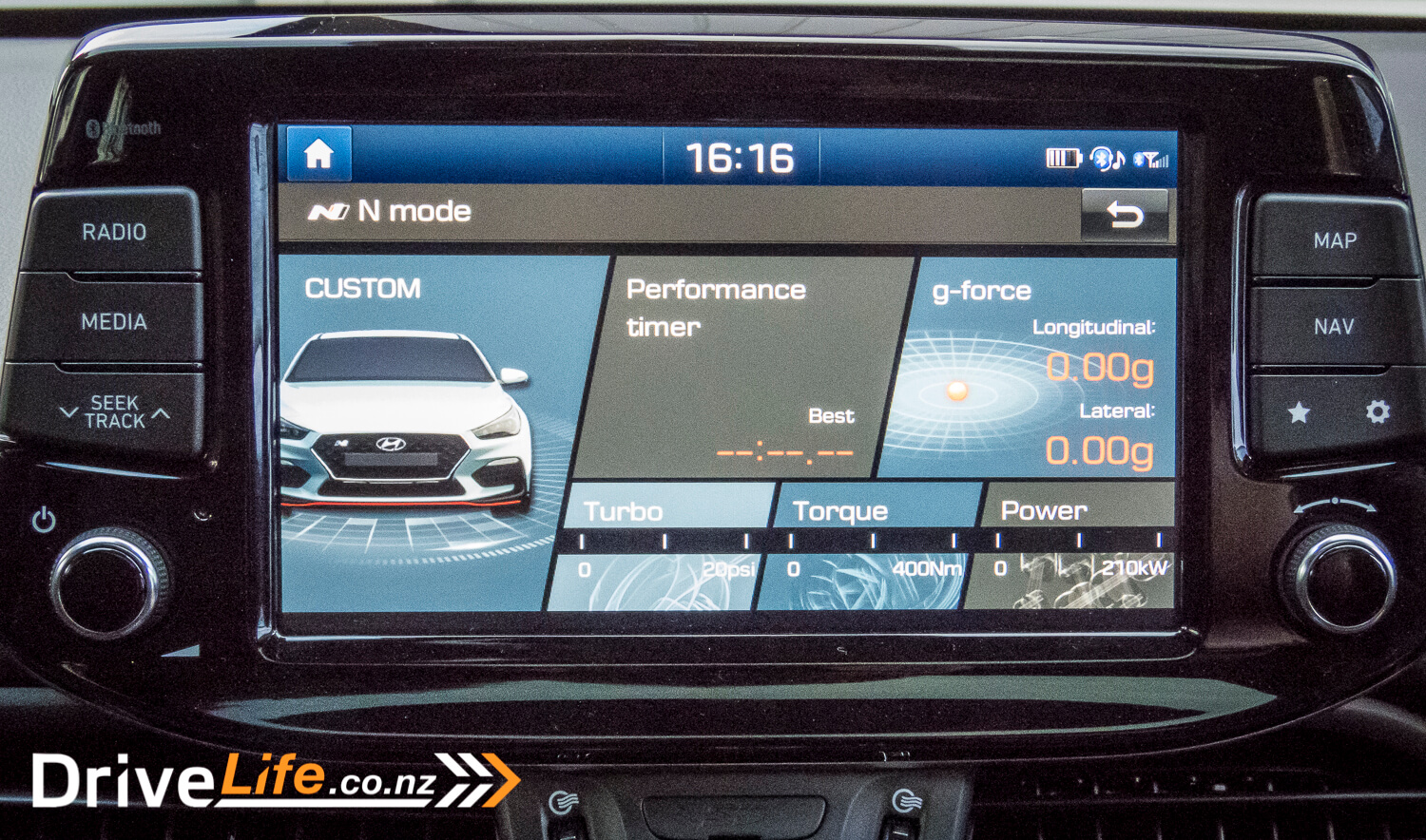
Like other Hyundai vehicles, the sat-nav has pre-set locations of fixed speed-cameras and will interrupt whatever is playing to forewarn you of them, which is definitely an appropriate feature to include for the majority of hot-hatch buyers.
Overall, the infotainment is one of the best I’ve used from Hyundai range. The screen was quick and responsive to the touch, has Hyundai’s usual user-friendly layout, plus all the cool bits packaged-in.
So, what’s not to like? The infotainment doesn’t have a hard home button. There is a soft home button on the screen, but it’s simply not as friendly as a physical one. The interface graphics also aren’t quite as fresh as some other manufacturers. The never-ending “streaming” bar when using Bluetooth has also made its way onto the i30N. I mentioned this in my review of the Hyundai Ioniq. It’s nothing bad, but just makes you say, “why?”
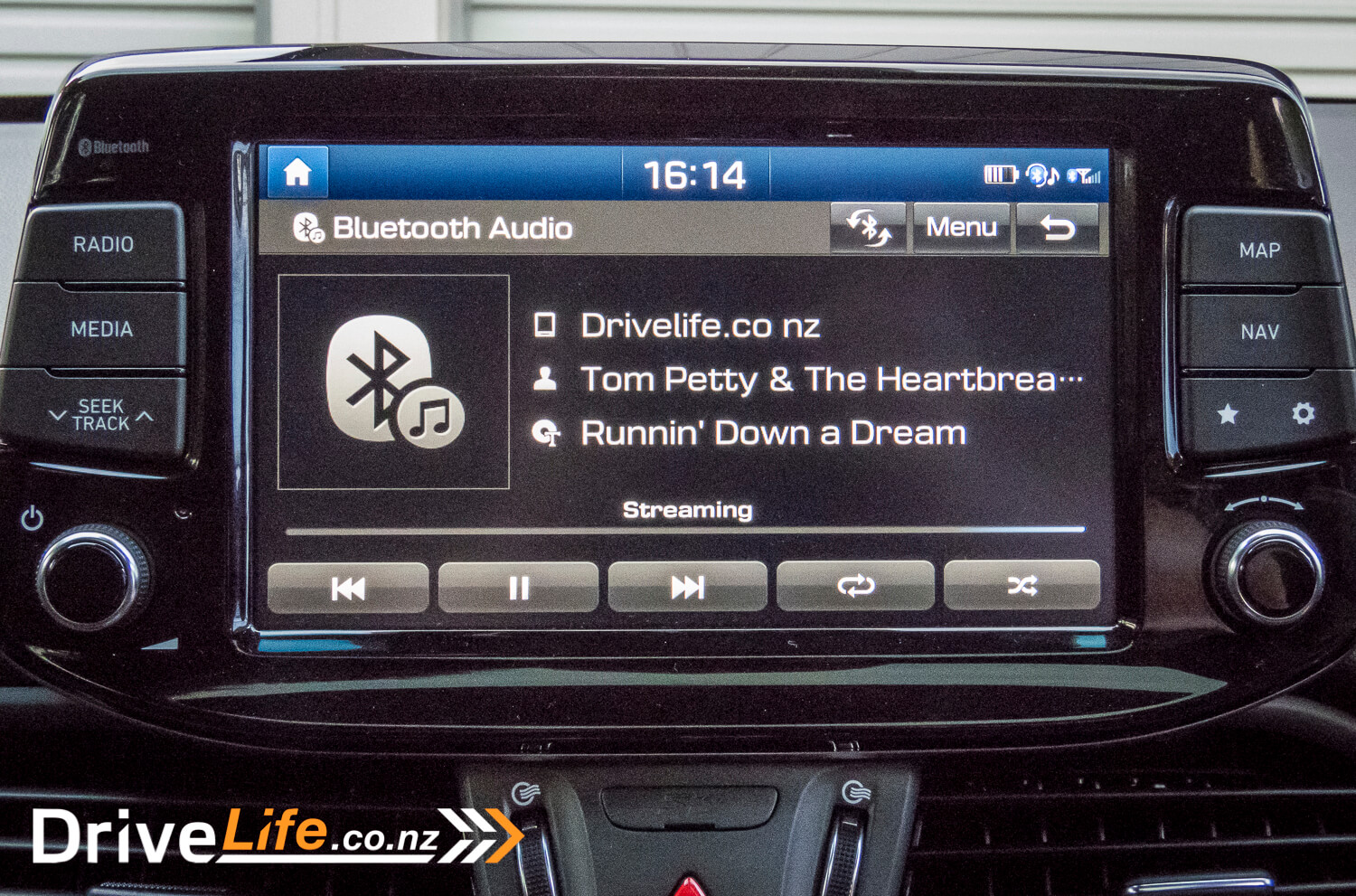
Perhaps the biggest downside of the tech is that the information isn’t 100% accurate. For example, that speed camera warning I mentioned earlier, the system told me the speed-zone for the Ngauranga Gorge was 50km/h, even though it’s an 80km/h zone. Also, the system warned me of a camera that historically existed, but was no longer there. Perhaps all it needs is an update, although it’s not what you’d expect from a brand-new vehicle.
But let’s be frank – are you really buying this car for the latest gadgets?
What Does The 2020 Hyundai i30 N Fastback Drive Like?
The i30N was Hyundai’s first real foray into the hot-hatch market. So, Hyundai had to put together quite the CV to make the i30N a credible contender. Fortunately for us, they did.
The “N” of the i30N represents Namyang, the location of Hyundai’s R&D facility in South Korea. Heading up this division is a bloke named Albert Biermann. I mentioned some BMW-esque features in the cabin earlier – Hyundai poached Biermann from BMW after 30 years of tenure, to run Hyundai’s Vehicle Test & High-Performance Development wing in April 2015, before being appointed the Head of the R&D Division in December 2018.
Importantly, Biermann is the guy who was the Technical Director of Sports and Touring Cars at BMW Motorsport back in 2000. The same era of BMW Motorsport when they produced arguably some of their greatest road cars, such as the E46 M3 and E39 M5.
The “N” badge also represents the i30N’s second spiritual home, the Nurburgring, where Hyundai’s testing centre for the i30N is located.
Hyundai has also accumulated some solid experience in the motorsport world. Hyundai established their motorsport arm in December 2012 and announced their return to WRC in 2014. Since their short return, they’ve managed 15 wins and were awarded their first constructors’ championship in 2019.
Combine the Hyundai’s WRC experience, hours of Nurburgring scrutineering, and garnish it with some brain power from BMW’s M division, and you’ve got all the ingredients to make a serious performance machine. Little wonder the hatchback won DriveLife’s Drivers’ Car of the Year award in 2019.
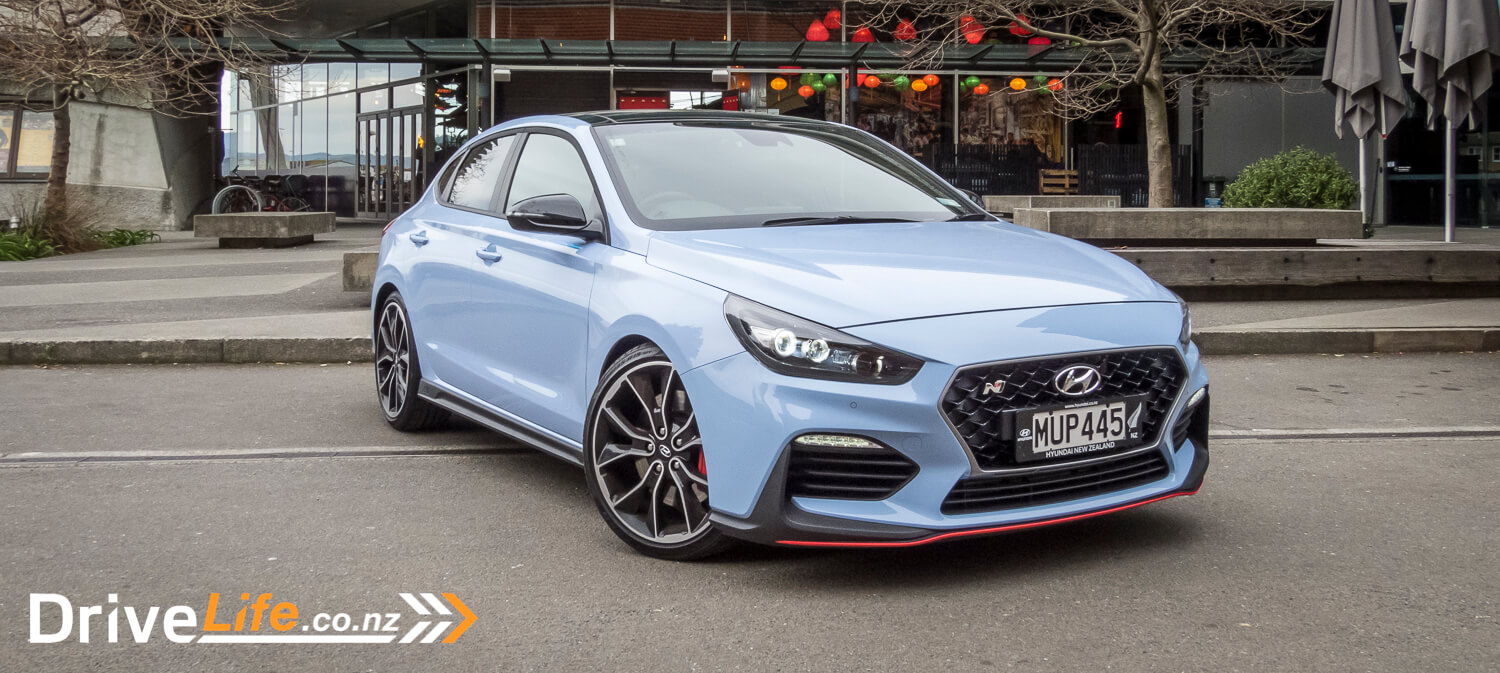
So, how does the Fastback compare to the hatch? Technically speaking, the Fastback’s marginal weight difference and the longer wheelbase should, in theory, mean a higher polar moment of inertia. In simple English, this means a slightly less twitchy front-end and more progressive steering response in corners. Hyundai also apparently made the body slightly stiffer, and made the suspension travel longer for a more compliant ride on the road.
The reality is that most of these changes aren’t too drastic, and you probably won’t notice them on the road. We also didn’t go to a race track, so we can’t be objective here either. But, why change what works? Because the i30N, no matter the form, is still an absolute riot!
Hyundai offers four pre-set drive modes, being Normal, Eco, Sport and N-mode. There’s also a fifth mode called Custom, which allows you to mix and match your favourite combinations of each mode via the infotainment screen.
First three modes are mostly self-explanatory in their function. As for N-mode, press the checkered flag button on the steering wheel and everything is turned up to 11.
In N-mode, the car adopts its most aggressive settings. The engine primes itself to unleash its full power, the steering and suspension firm up, throttle response and e-diff actuation sharpens, and the exhaust opens up to allow you to hear the full repertoire of noises this machine makes.
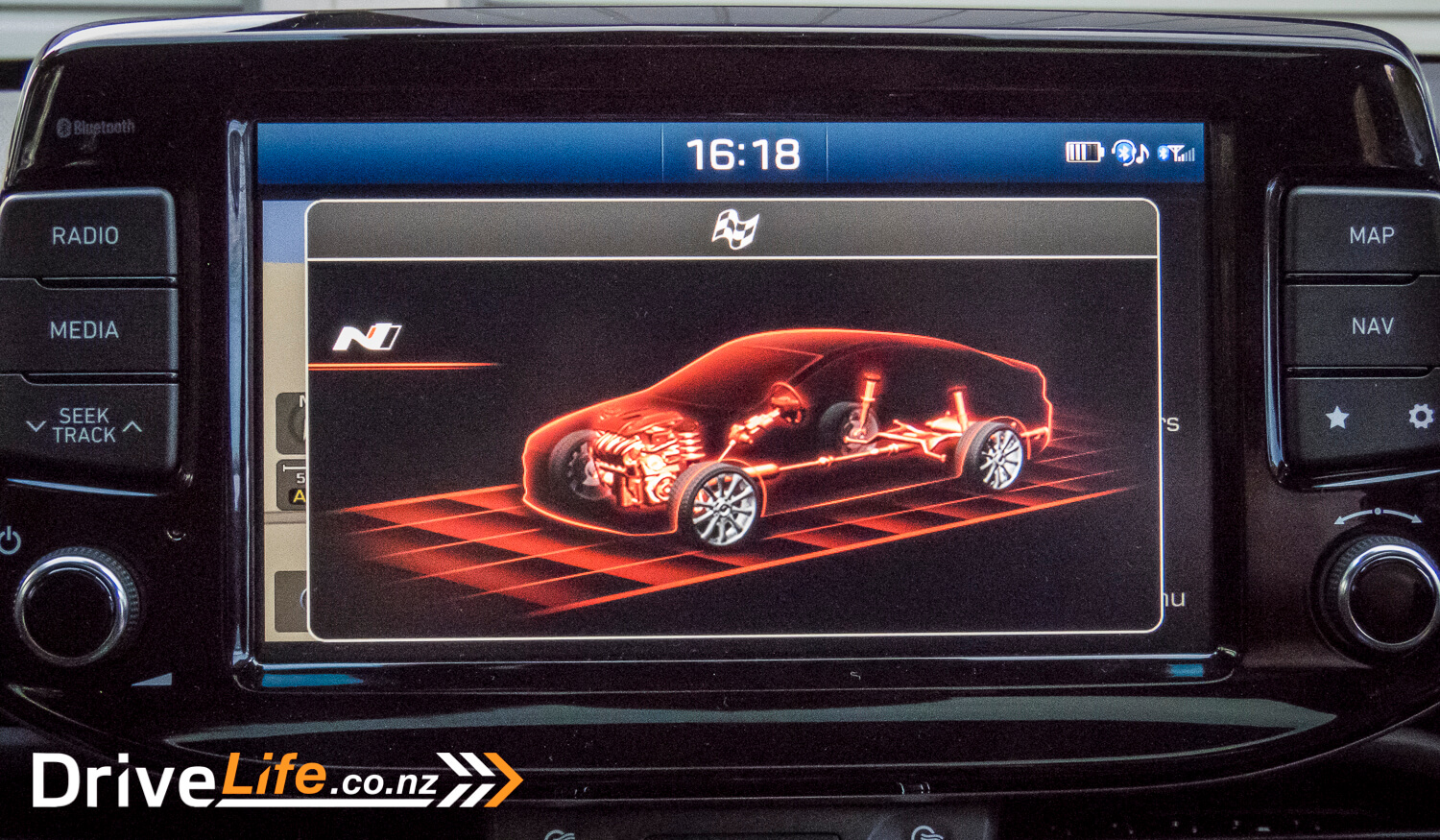
The 2.0-litre turbocharged 4-cylinder engine builds power linearly, with boost creeping on early. Like many 2-litre engines, there’s not a huge band of torque to sit on low-down, but it doesn’t take a lot to get the engine working to make the most of the 202kW on tap. You can really feel the engine come alive once you get up past 3500rpm. Find a twisty road, get the gear and revs right, and the i30N will hurtle you out of a corner. The i30N feels properly quick, and you can use the power without immediately going into license losing speeds.
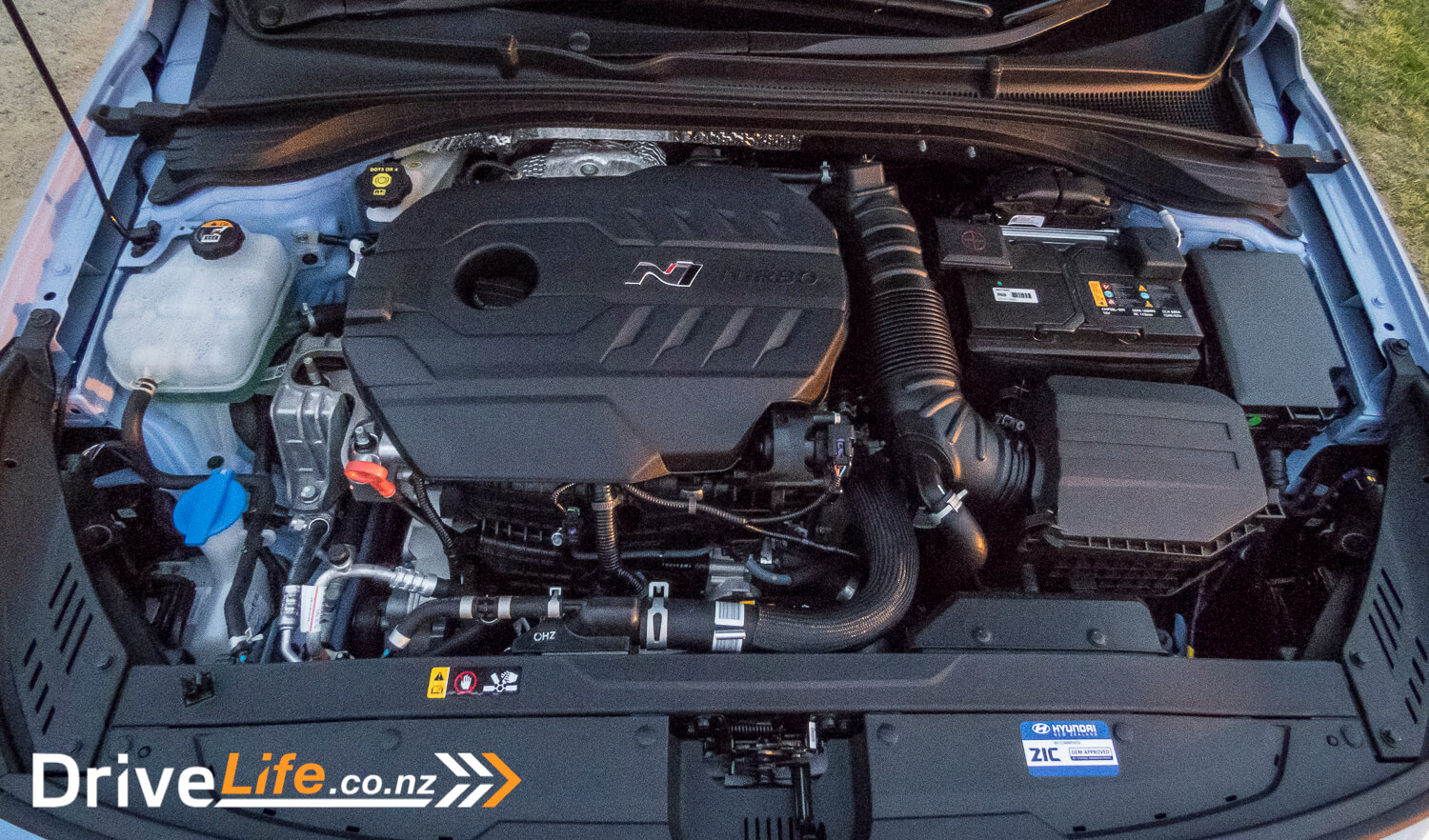
Even though the turbocharged engine doesn’t rev particularly high, the turbo spool and blow-off noises more than satisfy the high revving engine noise itch.
Which leads me onto the exhaust, and – oh man – that noise! Hyundai has added a valved exhaust to the i30N. Lift off the accelerator, and the car will snarl, crackle and pop, letting off controlled backfires under deceleration. My inner man-child meant I found myself simply putting the car into N-mode whenever I got the chance, just to hear the raucous noises this engine makes.
So you’ve got the power and the noise? What about the handling? Well, the i30N has incredible front-end grip, thanks in-part to Hyundai’s physics-manipulating electro-mechanical diff. Hyundai also equips the car with 19’’ Pirelli P-Zeros as standard. In fact, they’re P-Zero HN’s, which are designed specifically for the i30N. Both will keep the i30N adhered to the road, and will stubbornly maintain your line through a corner.
The i30N seriously flatters your driving ability. You could objectively be a very average driver, yet the i30N will make you feel like Hayden Paddon himself. And remember – you can still take your kids to school in this thing!
Despite your new found confidence, you can’t defy physics forever. Fortunately, the brakes on the i30N have good feel and stopping power, even though they do not adorn a swanky name.
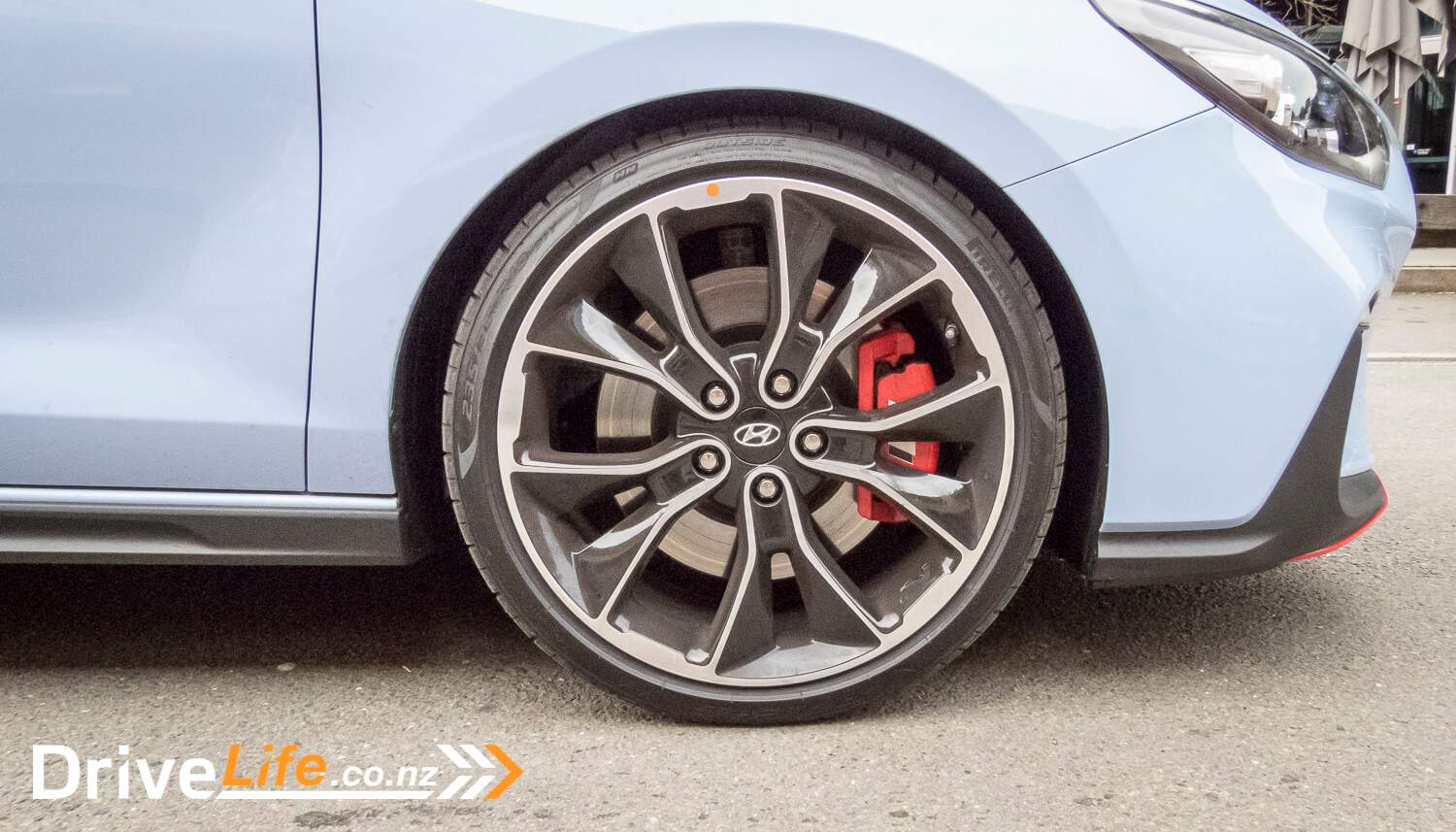
The steering is another highlight of the i30N. In N-mode (and Sport mode), the steering becomes noticeably weightier and offers an excellent amount of feedback. There’s a reassuring control to the vehicle, being responsive, without feeling too twitchy.
I did notice that torque steer seemed better managed on the Fastback. I briefly spent time in an older i30N hatch and recall it being much harsher. This was a few years back, so perhaps this is just an incremental improvement by Hyundai.
N-mode also sets the suspension to its most aggressive setting, which makes the i30N noticeably firmer. On the race track, this would be excellent, but on New Zealand backroads, it’s a tad excessive. It’s so firm, that I noticed an interior rattle had developed on our test vehicle when driving in N-mode around the streets of Wellington.
This is where the 5th custom mode really comes into its own. Dial the suspension back using the menus on the infotainment and leave everything else in full attack mode. You’ll have one of those, ‘have your cake and eat it too’, moments.
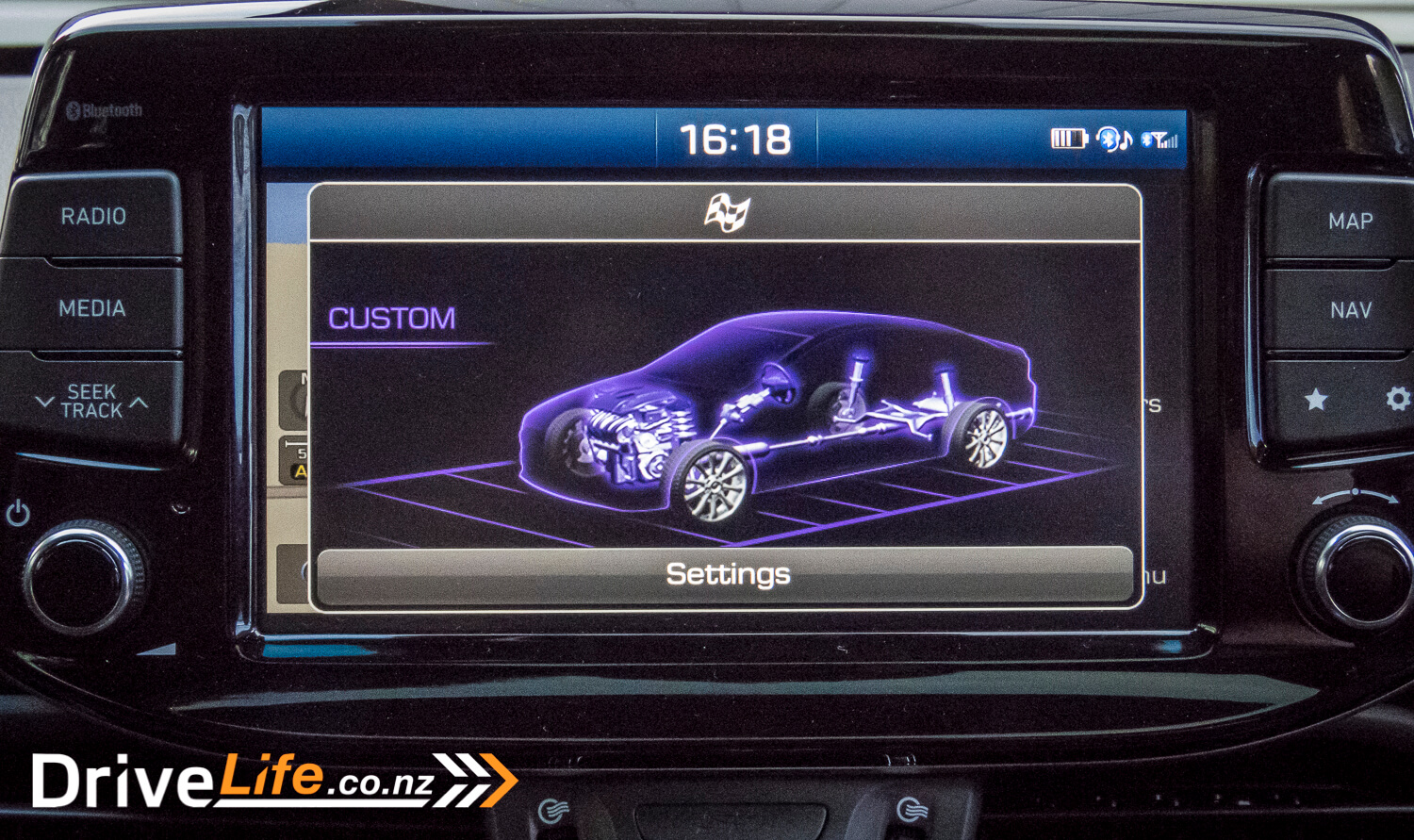
After you’ve finished blasting through some backroads, a mere push of a button will noticeably slacken everything off. In Eco-mode, the steering lightens, the throttle firms, the suspension becomes more supple, the engine relaxes, and the exhaust tones it down a notch. Even my Mum was able to tell from the passenger’s seat – so you definitely know it makes a difference!
I should put an asterisk above supple suspension, because even in the softest setting, the i30N is still a stiff car. To Hyundai’s credit, the ride is actually decent in softer modes. Plus, the wonderful sports seats cushion you from a fair amount of the harshness. I imagine that without these seats, living with an i30N would be a lot more of a chore.
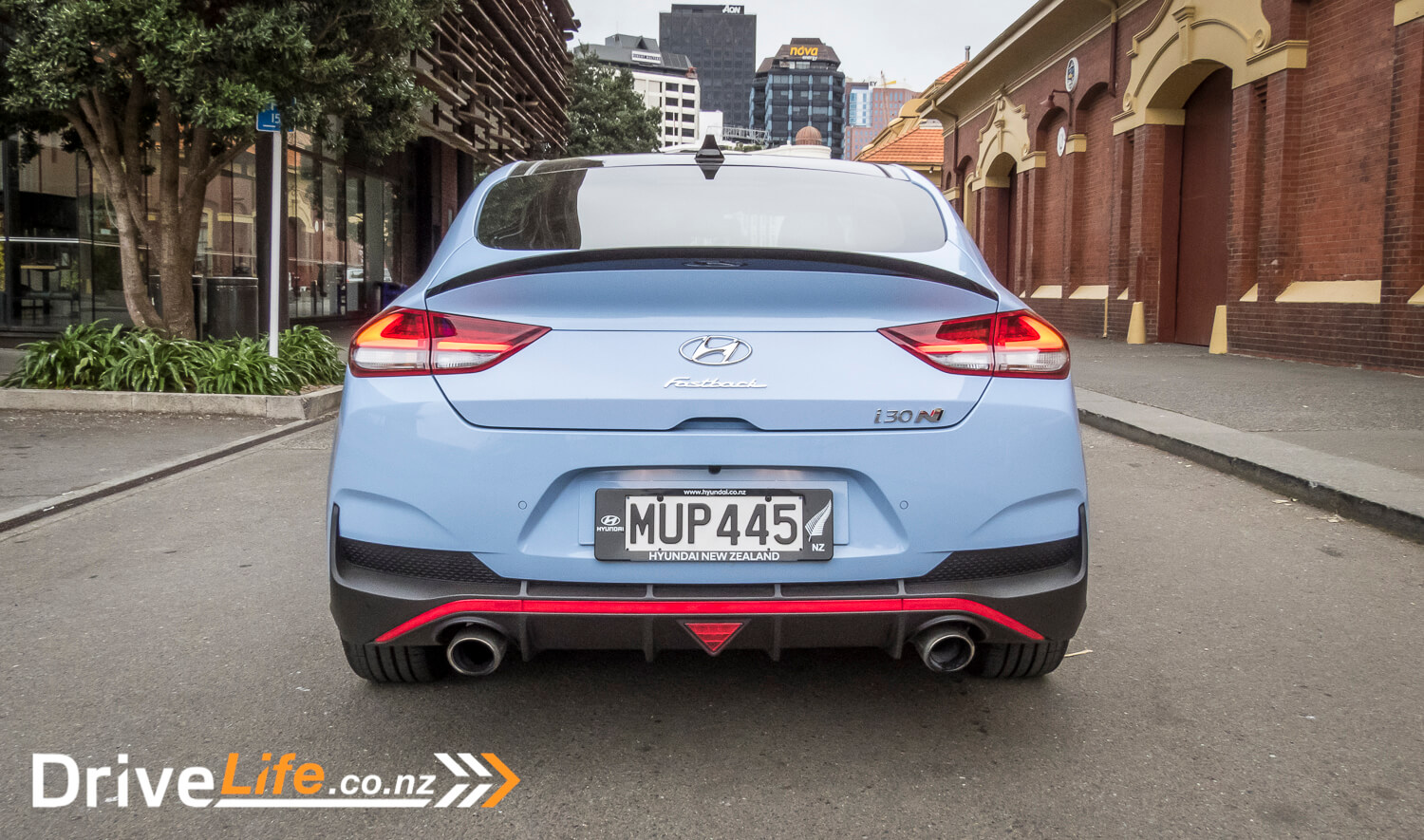
The 6-speed manual controlling all the power has a nice short throw to it. The clutch has a reassuring weight to it – you know that it can handle the power without feeling like you’re shifting lead with your foot. I did notice the clutch does have quite a late engagement, which is something you’ll need to get used to.
The i30N also offers automatic rev-matching on downshifts. I know there are mixed feelings on this, but honestly, the driving experience is much better with it on.
Why? Well, this requires a bit of background. Nearly all modern cars use an e-throttle as opposed to a mechanical one, meaning there’s no physical connection between the accelerator pedal and the driver. There are many reasons for this, but one hallmark of an e-throttle is that there’s generally a small lag between when you press the throttle and when it reacts. Do you see where I’m going here?
Don’t get me wrong, I love trying my heel and toe action out, but generally speaking it’s much harder to do well in a car with an e-throttle versus one with a direct connection. Hyundai has also managed to absolutely perfect the auto-rev, that it adds much more to the driving experience than it takes away.
Still not convinced? There’s a button on the steering wheel for you to flick-it off. If you want it on (and I absolutely recommend you do), it can work in every mode, except for Eco.
Speaking of Eco, I imagine fuel economy isn’t high on the priorities list, but if you choose to potter around in Eco-mode, the i30N can be decently efficient. On my usual commute of mostly motorway, I was managing figures in the low 8L/100Kms range. Start driving the i30N like you’re meant to, and you’ll easily run into the mid 10L/100Kms range. But who cares really, it’s about smiles-per-gallon, right?
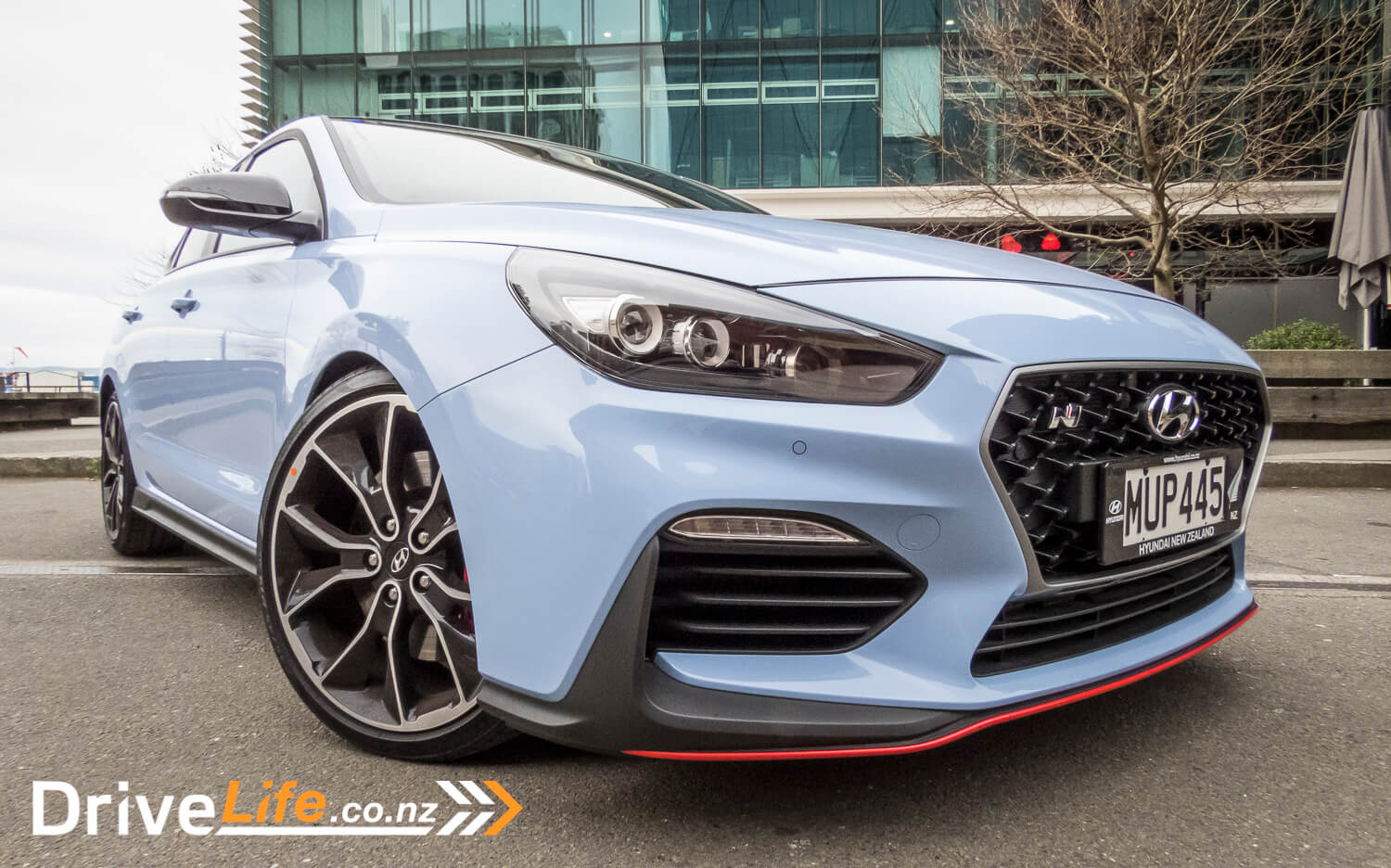
The i30N comes with Hyundai’s SmartSense package, which offers a few of the latest safety features. Hyundai has passively integrated the driver safety technology. It’s there to save you when you need it, but won’t disrupt driving experience, which is exactly what you want on a performance vehicle.
Hyundai also gives you basic cruise control. The only trouble is you can’t see the speed you’ve set it to. If you adjust it using the steering wheel controls, you’ll need to pay attention to the speedo if you’ve not been counting the clicks.
Another little bonus Hyundai has thrown in are steering-wheel triggered exterior LED lights. When driving with the headlights on, these lights will switch-on based on the direction the vehicle is turning to offer you a bit of extra visibility as you round the corner. It was a cool little touch, and genuinely useful on some bits of tight road.
Although Hyundai offers Auto Dusk Sensing headlights as standard, I was left wanting for auto-high beams. Otherwise, there wasn’t anything I truly missed technology wise. I couldn’t care less about radar-cruise or any other semi-autonomous assistance stuff. The i30N is made for the driver. Besides, if you can’t live without some of those features, there’s plenty of highly competent crossovers on the market to coddle you and while you drink your soy milk latte.
What’s The Competition For The 2020 Hyundai i30 N Fastback?
The Hyundai might seem expensive amongst competitors, though this is slightly misleading. The Hyundai has greater standard features than a lot of the competition. For example, LED headlights come standard on the Hyundai. On the Golf GTI, they’re a $3450 option. Despite the list being short some offerings, such as the Cupra Leon which isn’t currently available at the time of this writing, there are some great hot-hatch options in the market.
| Brand/Model | Engine | Power (kW)/ Torque (Nm) | Acceleration, 0-100 kph | Economy, L/100km (claimed) | Boot Space, Litres | Price |
| Volkswagen Golf R | 2-litre 4-cylinder Turbocharged Petrol | 228/400 | 4.6 | 7.2 | 343 | $73,990 |
| Mercedes A250 4Matic | 2.0-litre 4-cylinder Petrol Engine | 165/350 | 6.2 | 6.6 | 355 | $64,400 |
| Renault Megane RS | 1.8-litre 4-cylinder Turbocharged Petrol | 205/390 | 5.8 | 7.4 | 434 | $59,990 |
| Subaru WRX STI | 2-litre horizontally opposed 4-cylinder Turbocharged Petrol | 221/407 | 4.9 | 8.4 | 460 | $59,990 |
| Honda Civic Type R | 2-litre 4-cylinder Turbocharged Petrol | 228/400 | 5.7 | 8.8 | 414 | $59,990 |
| Hyundai i30N Fastback | 2-litre 4-cylinder Turbocharged Petrol | 202/353 | 6.1 | 8 | 436 | $59,990 |
| Ford Focus ST | 2.3-litre 4-cylinder Turbocharged Petrol | 206/400 | 5.7 | 8.6 | 273 | $59,490 |
| Skoda Octavia Wagon RS | 2-litre 4-cylinder Turbocharged Petrol | 180/370 | 6.7 | 7.0 | 610 | $57,490 |
| Volkswagen Golf GTI | 2-litre 4-cylinder Turbocharged Petrol | 169/350 | 6.4 | 6.6 | 380 | $56,990 |
| Mini John Cooper Works | 2-litre 4-cylinder Turbocharged Petrol | 170/320 | 6.3 | 6.9 | 211 | $55,400 |
| Hyundai i30N Hatchback | 2-litre 4-cylinder Turbocharged Petrol | 202/353 | 6.1 | 8 | 381 | $54,990 |
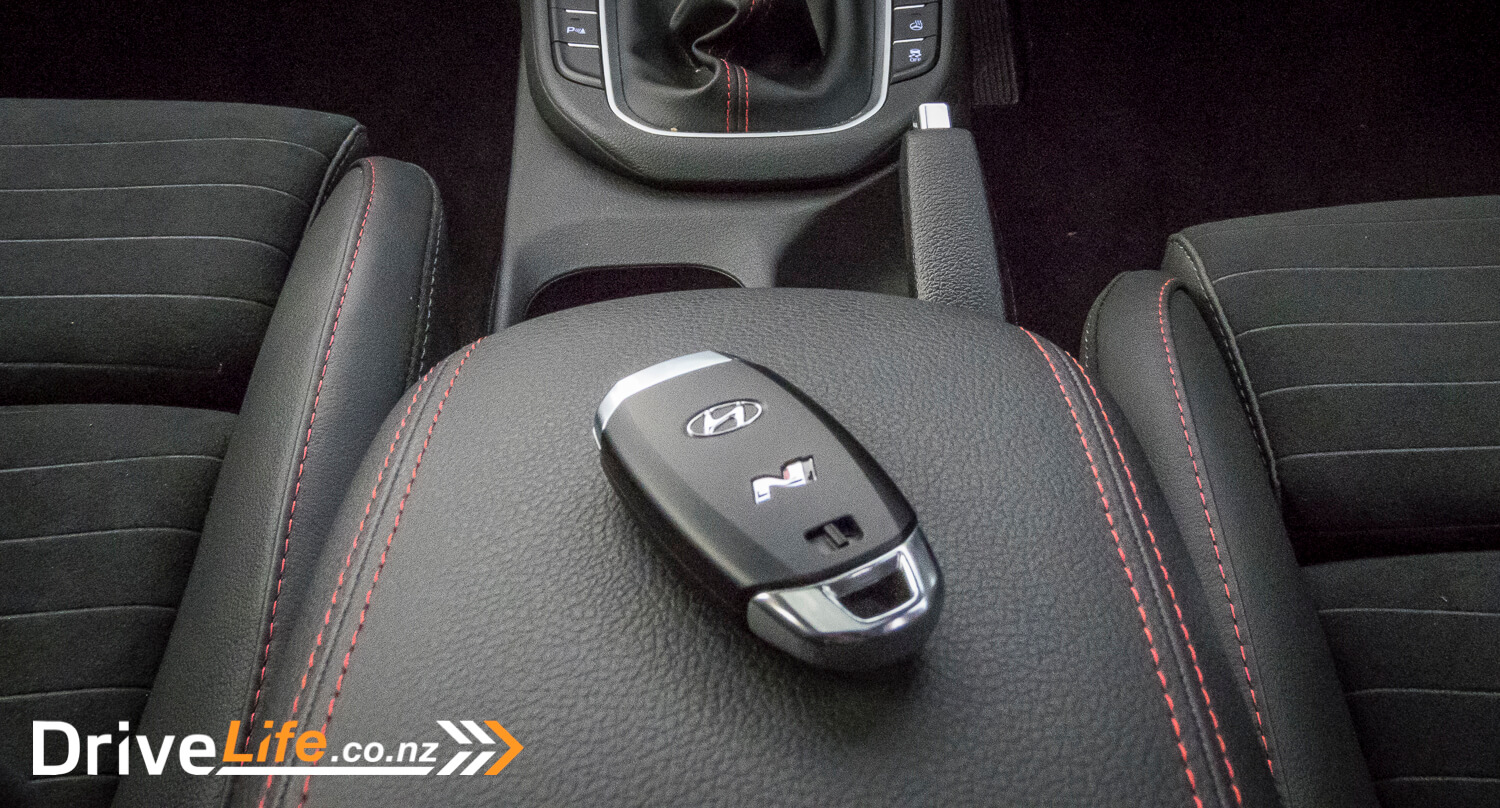
What’s The Pros And Cons For The 2020 Hyundai i30 N Fastback?
Pros
- Driving experience
- Fastback looks
- Proper Manual transmission
- Handling and front end grip
- Perfect auto-rev matching
- Excellent seats
- Premium touch-points
- Exhaust noises
- Turbo noises
- My happy noises from driving it
Cons
- Economy car plastics
- Rear headroom
- Rear strut brace impeding on boot space
- Dated sat-nav information
2020 Hyundai i30N Fastback – Specifications
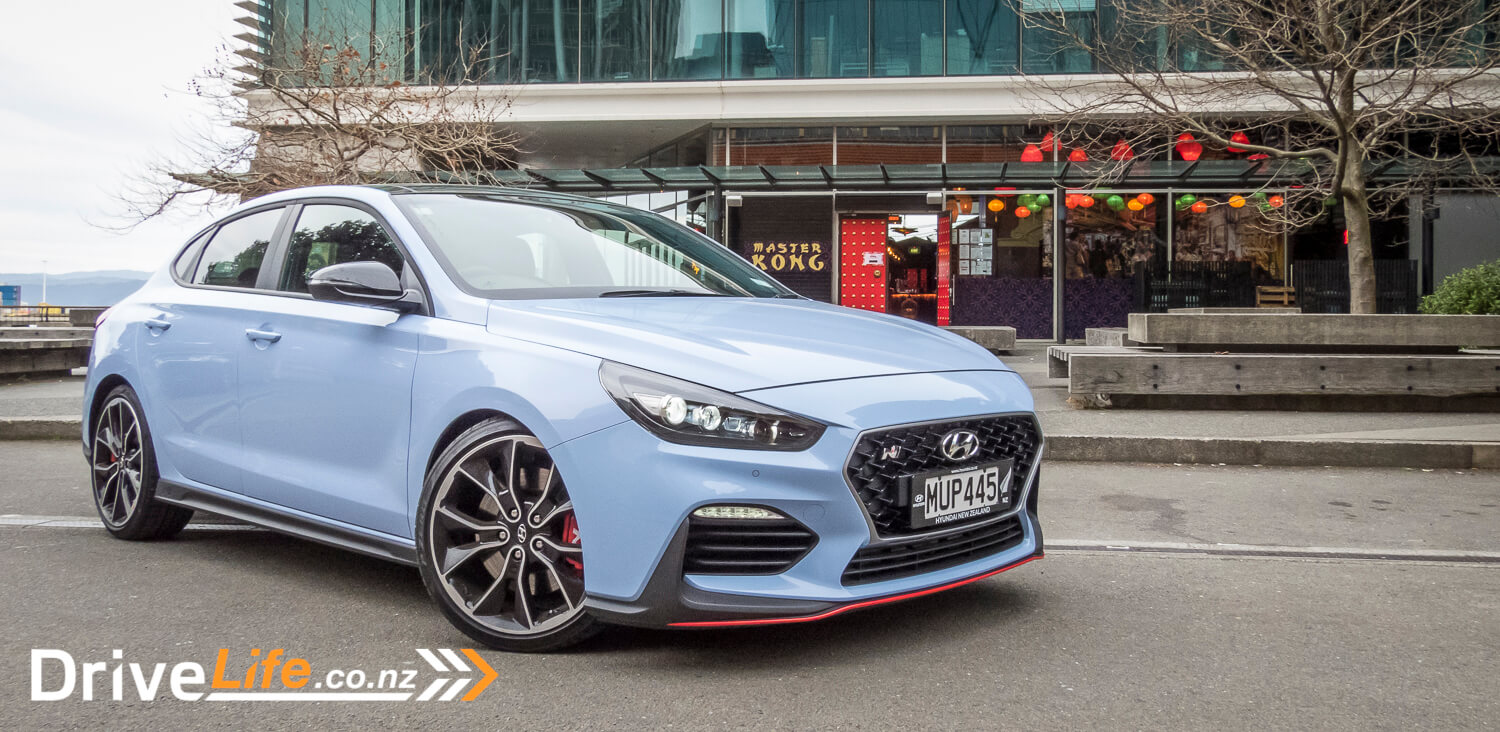
| Vehicle Type | 5-door Medium Hatchback |
| Starting Price | $59,990 |
| Price as Tested | $59,990 |
| Engine | 2-litre turbocharged 4-cylinder, petrol engine |
| Power, Torque (kW/Nm) | 202/353 (202/378 with Overboost) |
| Transmission | 6-speed Manual Transmission |
| Spare Wheel | Space saver |
| Kerb Weight, Kg | 1,429 |
| Length x Width x Height (mm) | 4455 x 1795 x 1417 |
| Cargo Capacity, litres | 436/1337 |
| Fuel tank Capacity litres | 50 |
| Fuel Economy, L/100km | Advertised Spec – 8.0 Real-World Test – 9.5 |
| Towing Capacity Kg, unbraked/braked | N/A |
| Turning circle metres | 11.6 Small: 6-10m / Medium 10-12m / Large 12m+ |
| Warranty | 10 year / 200,000 km anti-perforation corrosion body warranty 3 year / 100,000 km mechanical warranty 3 year / 100,000 km roadside assistance package |
| ANCAP Safety Ratings | 5 Star |


